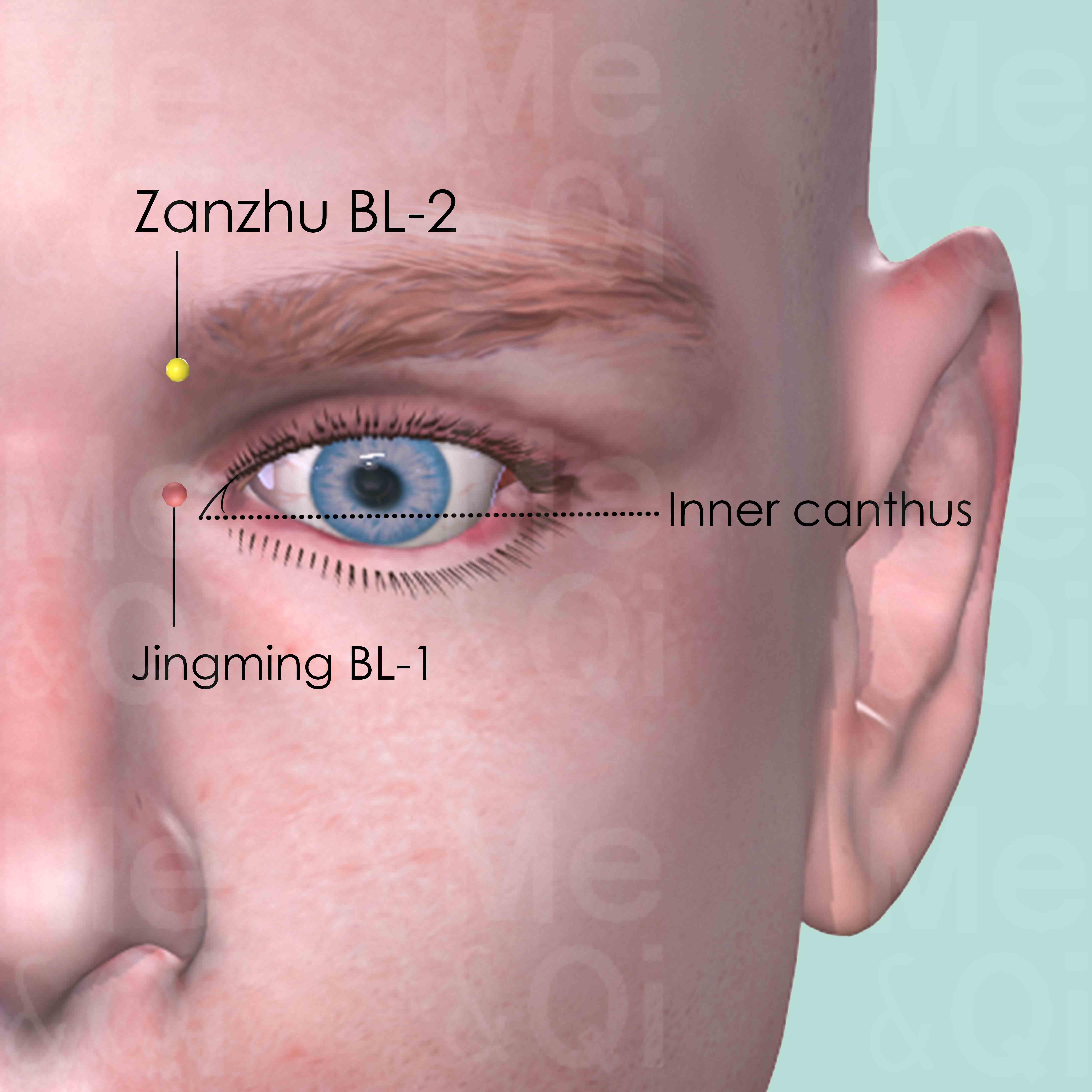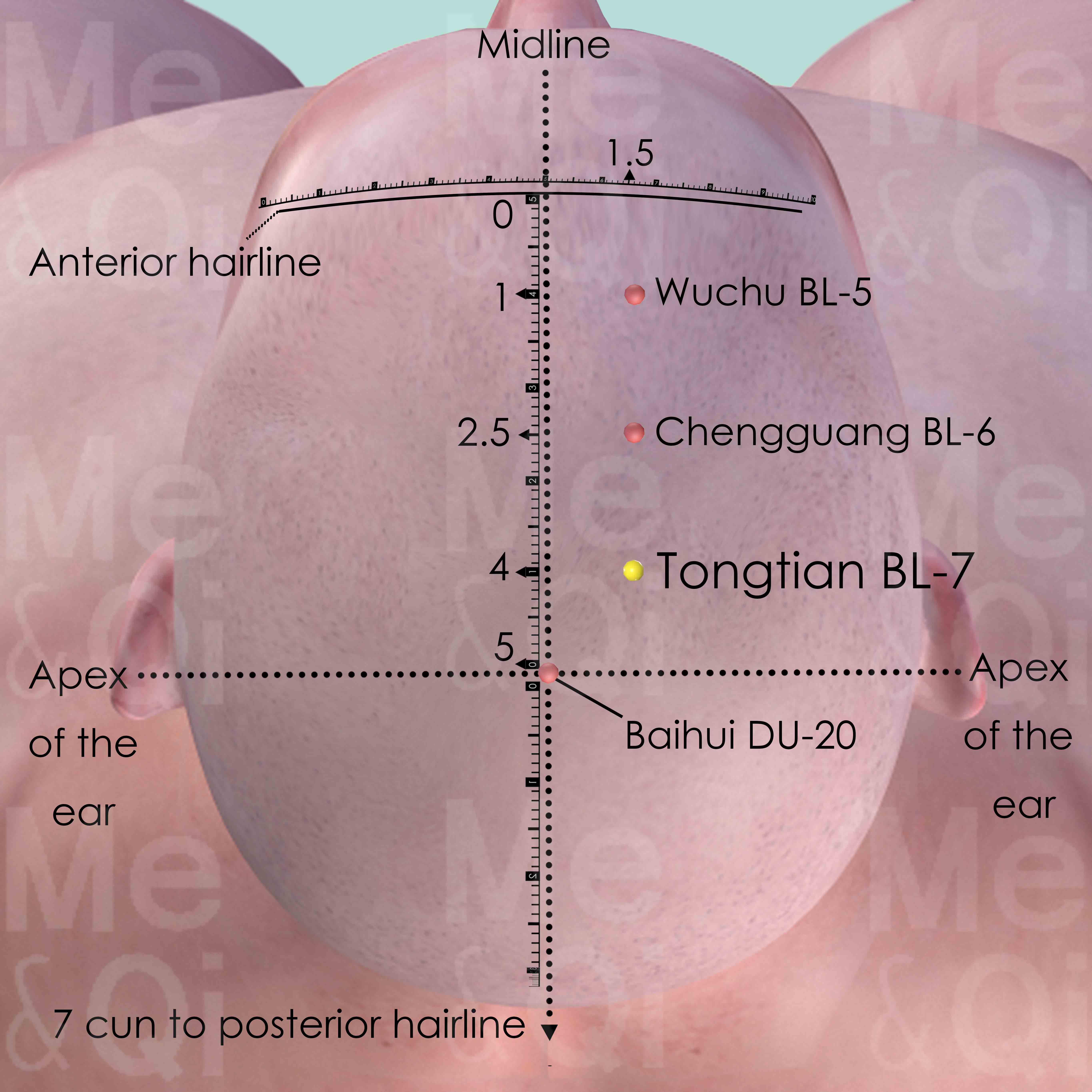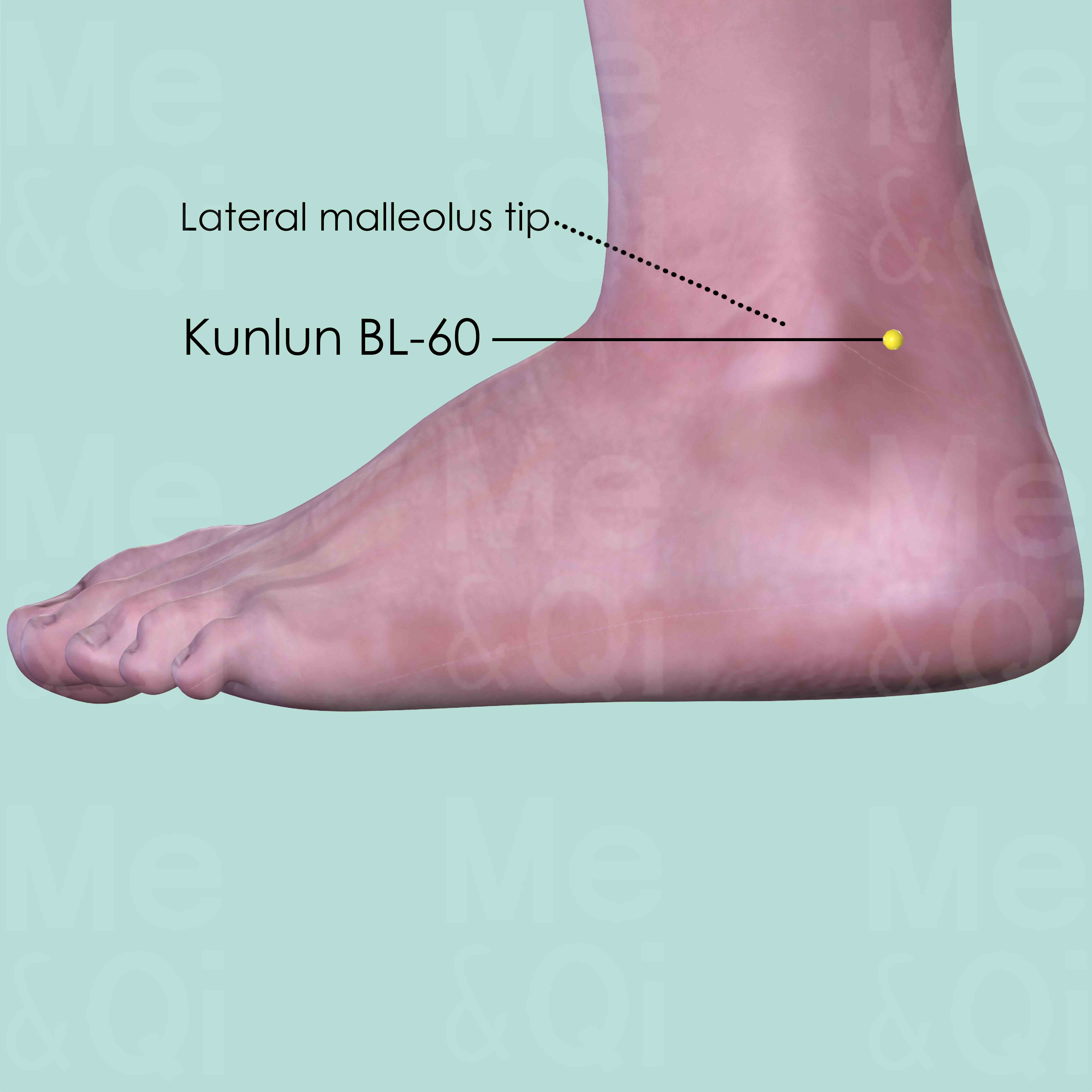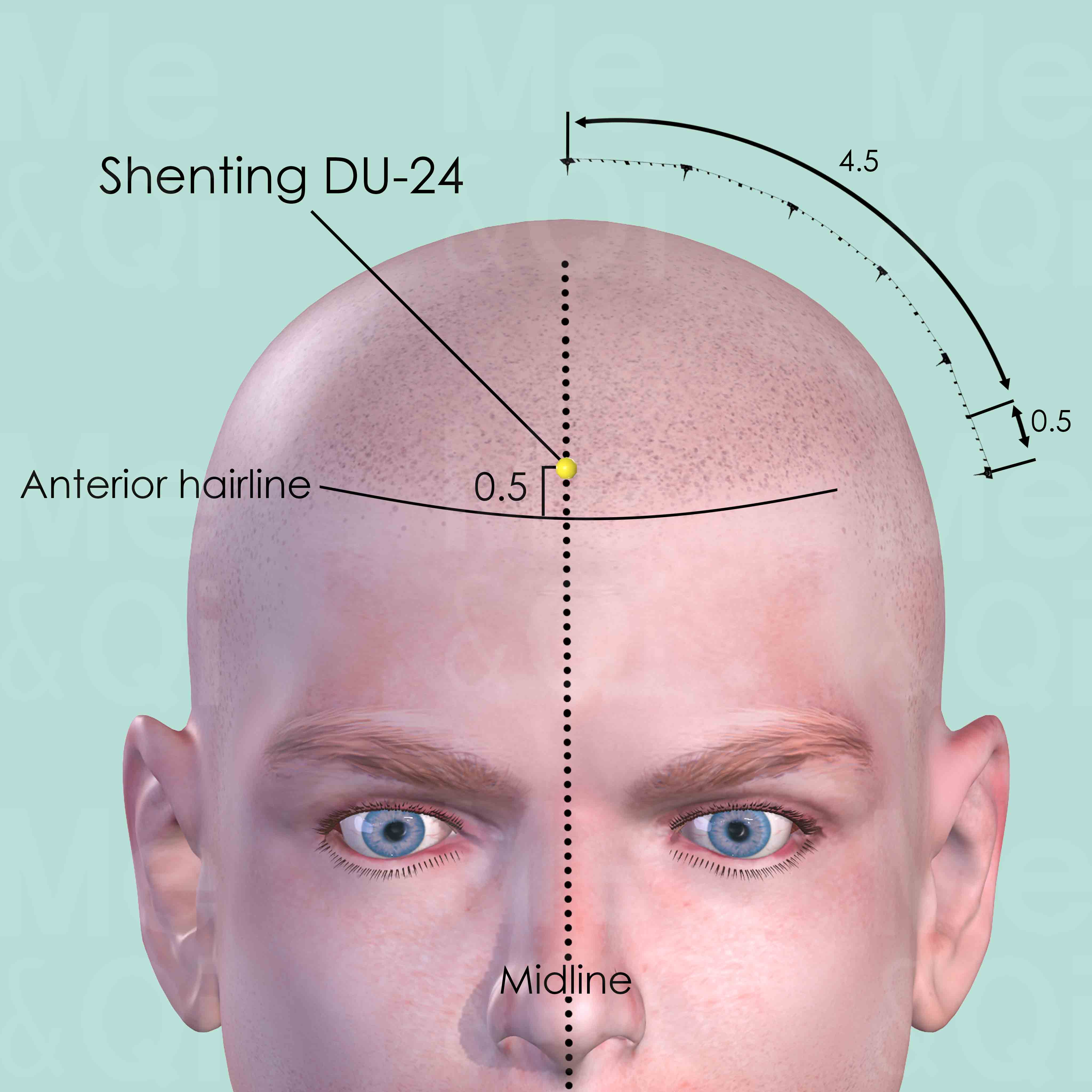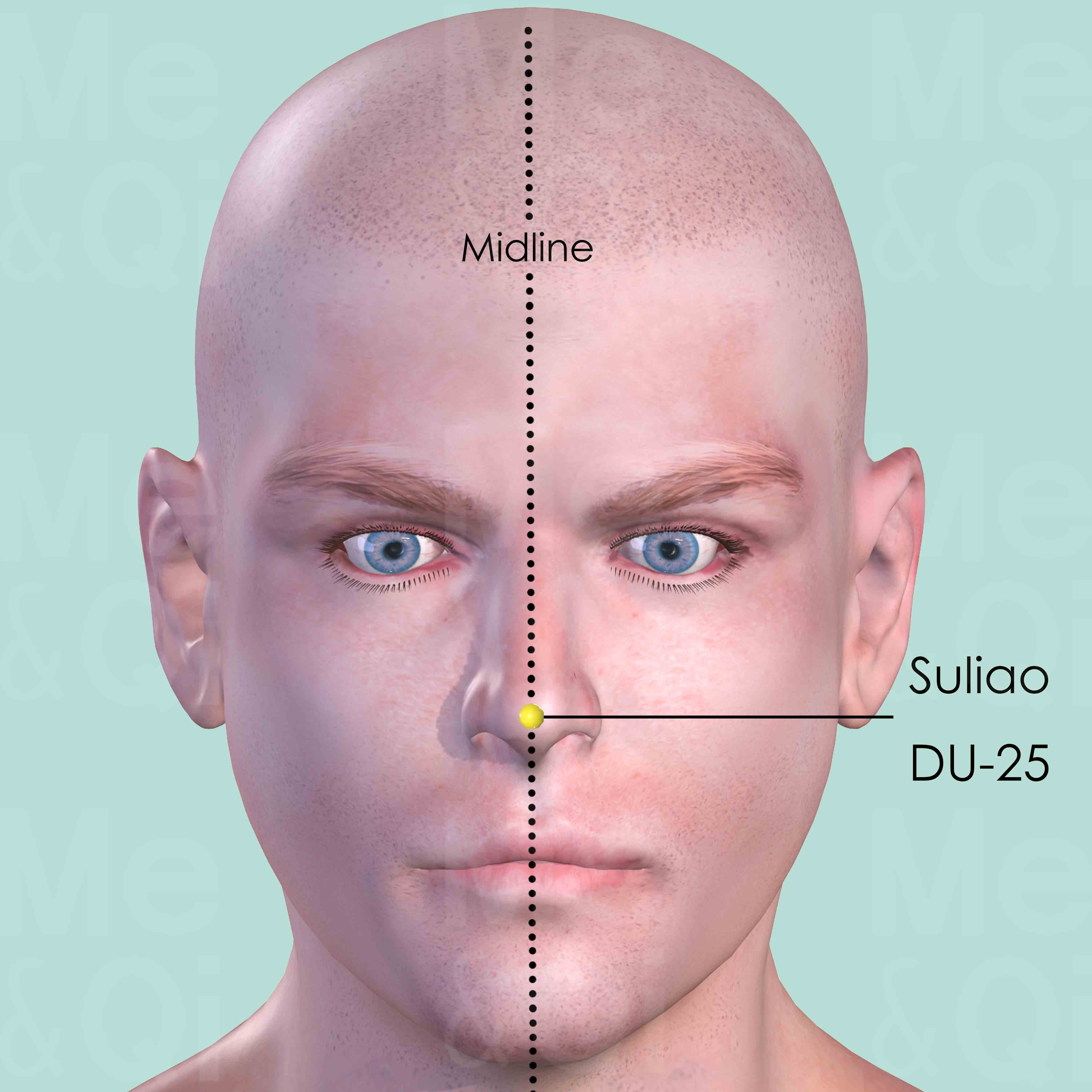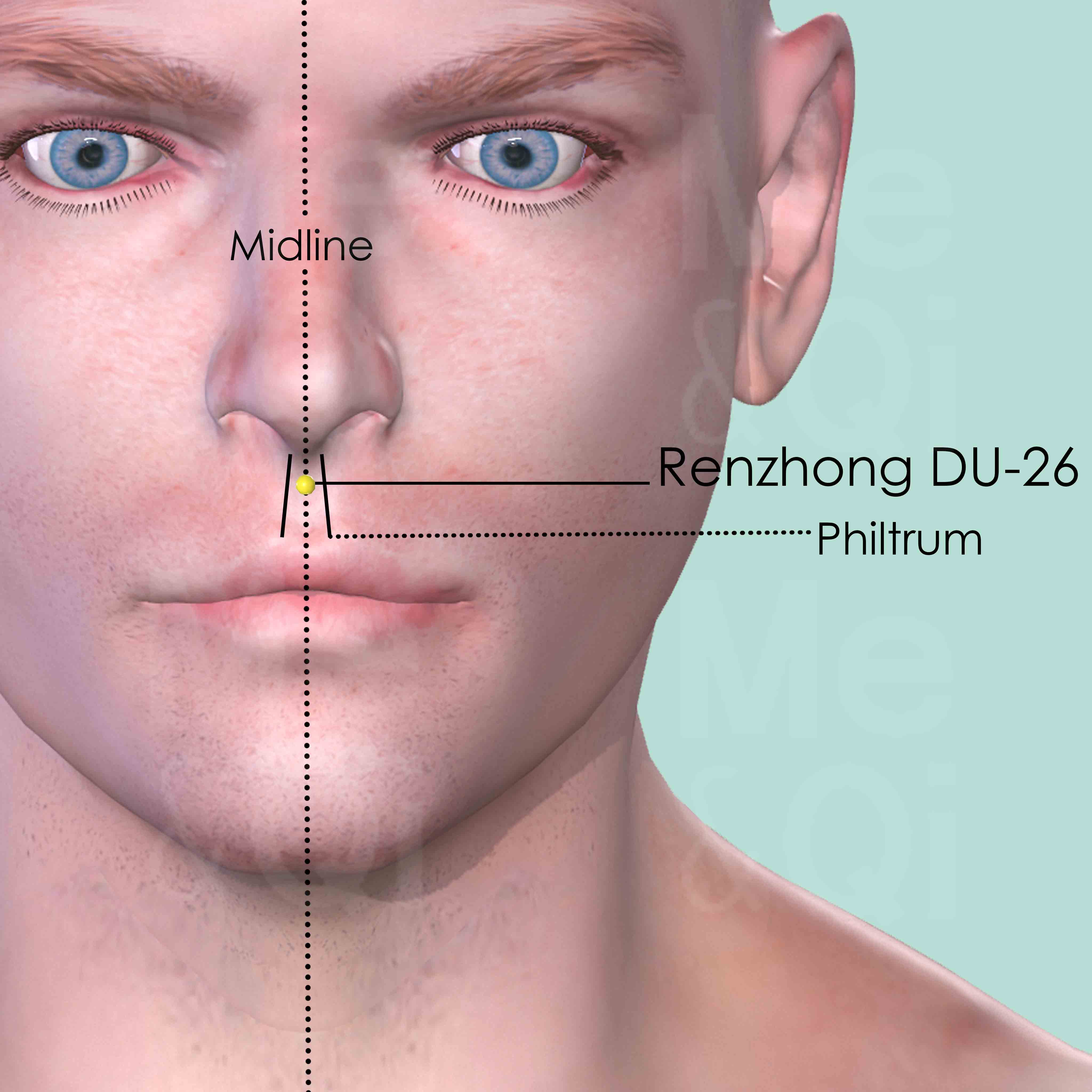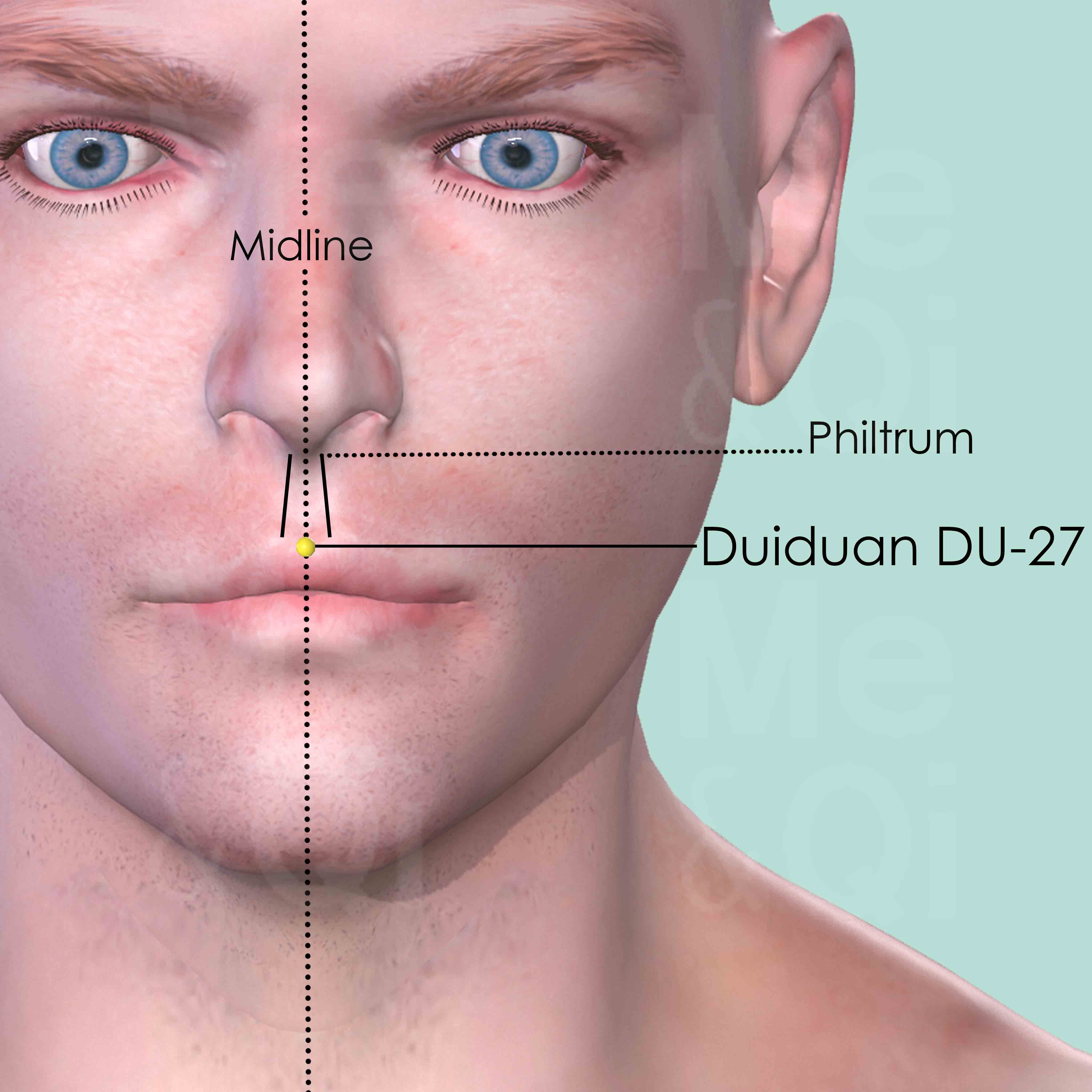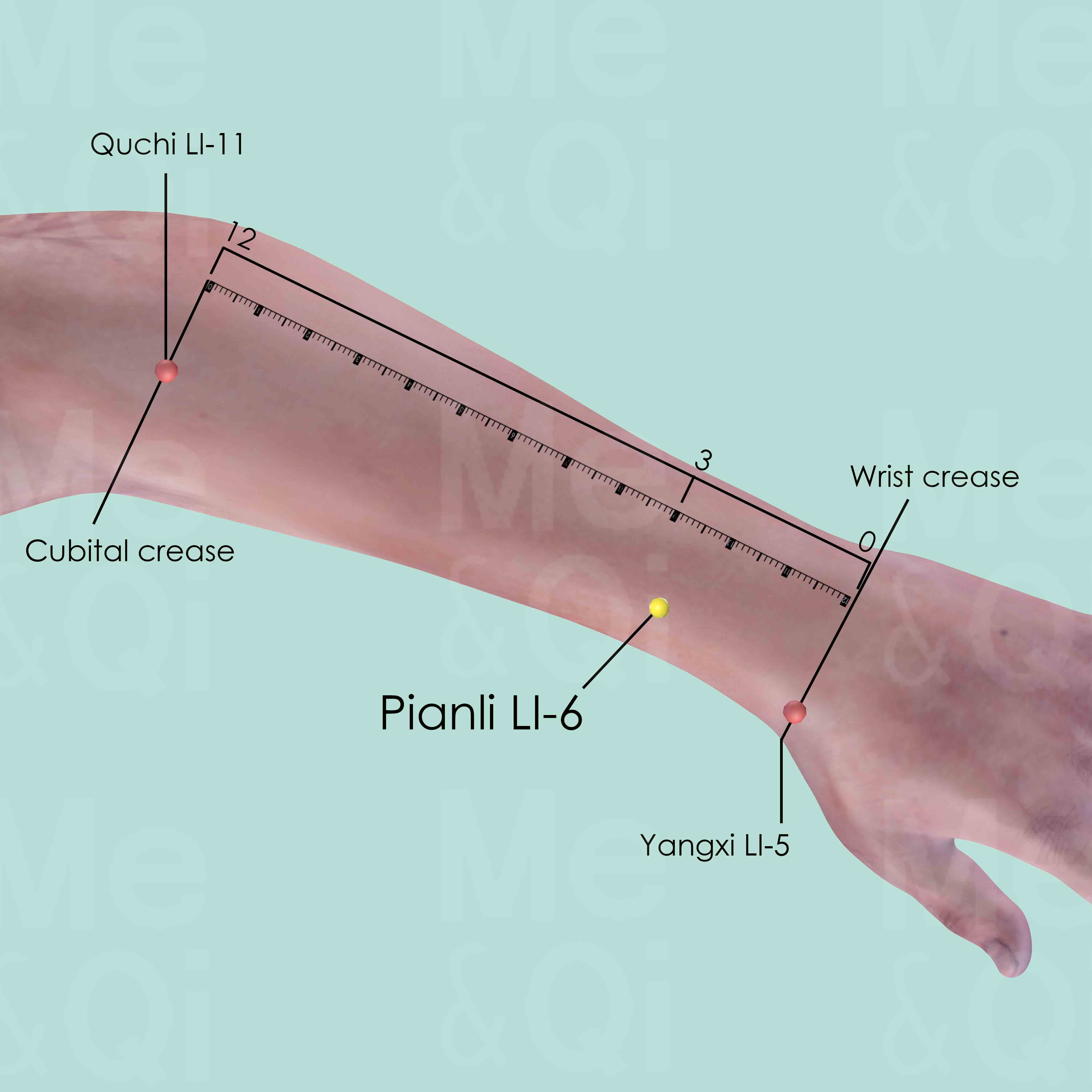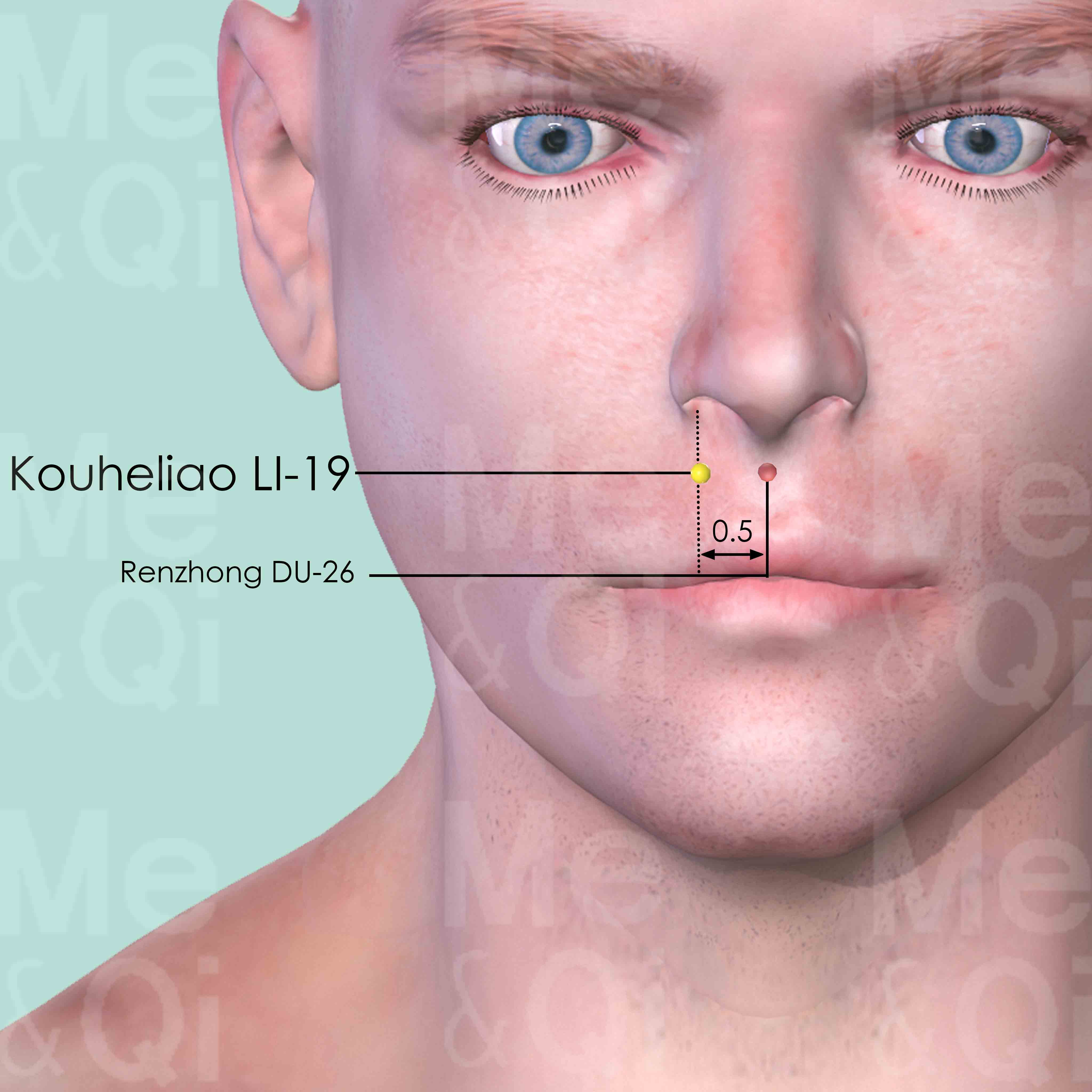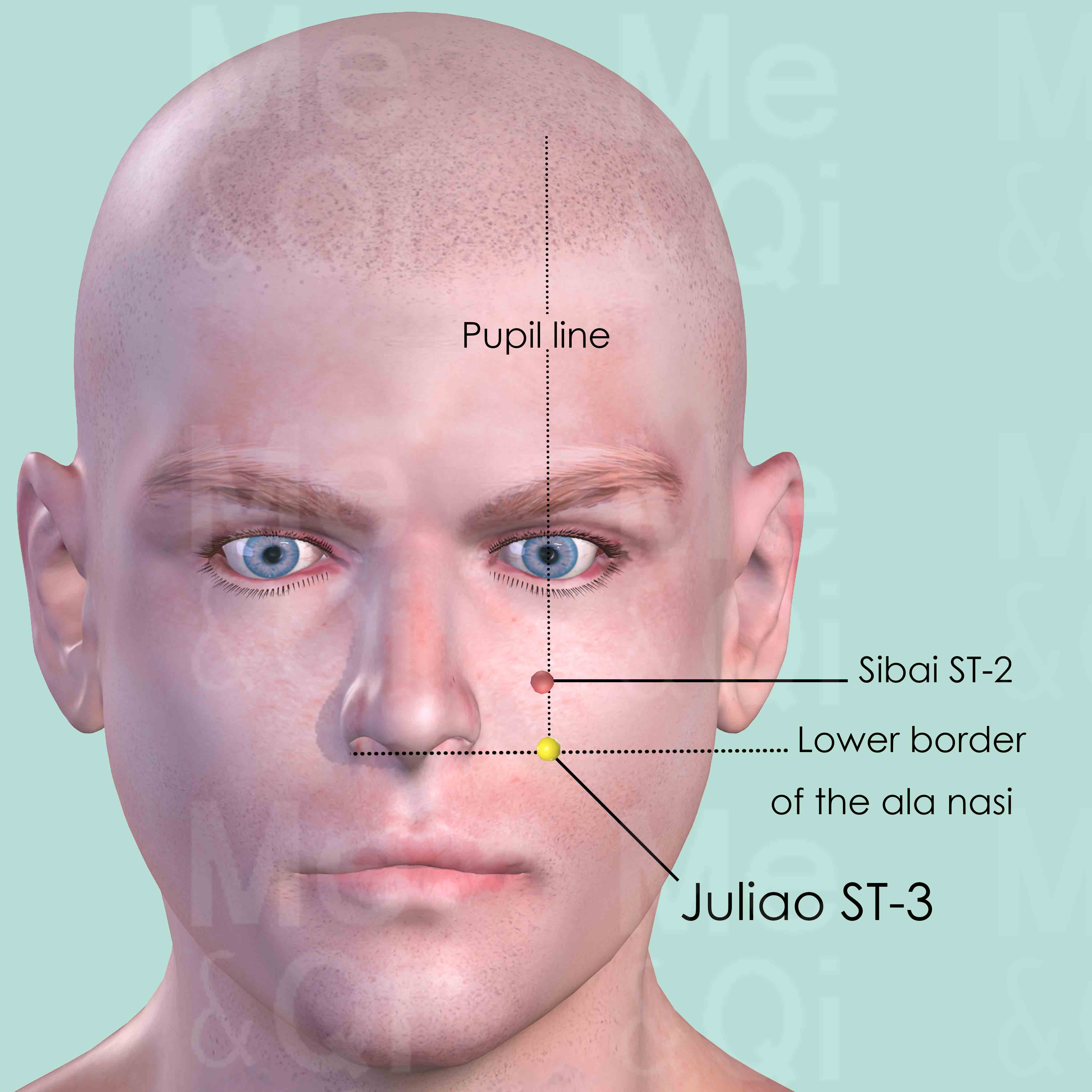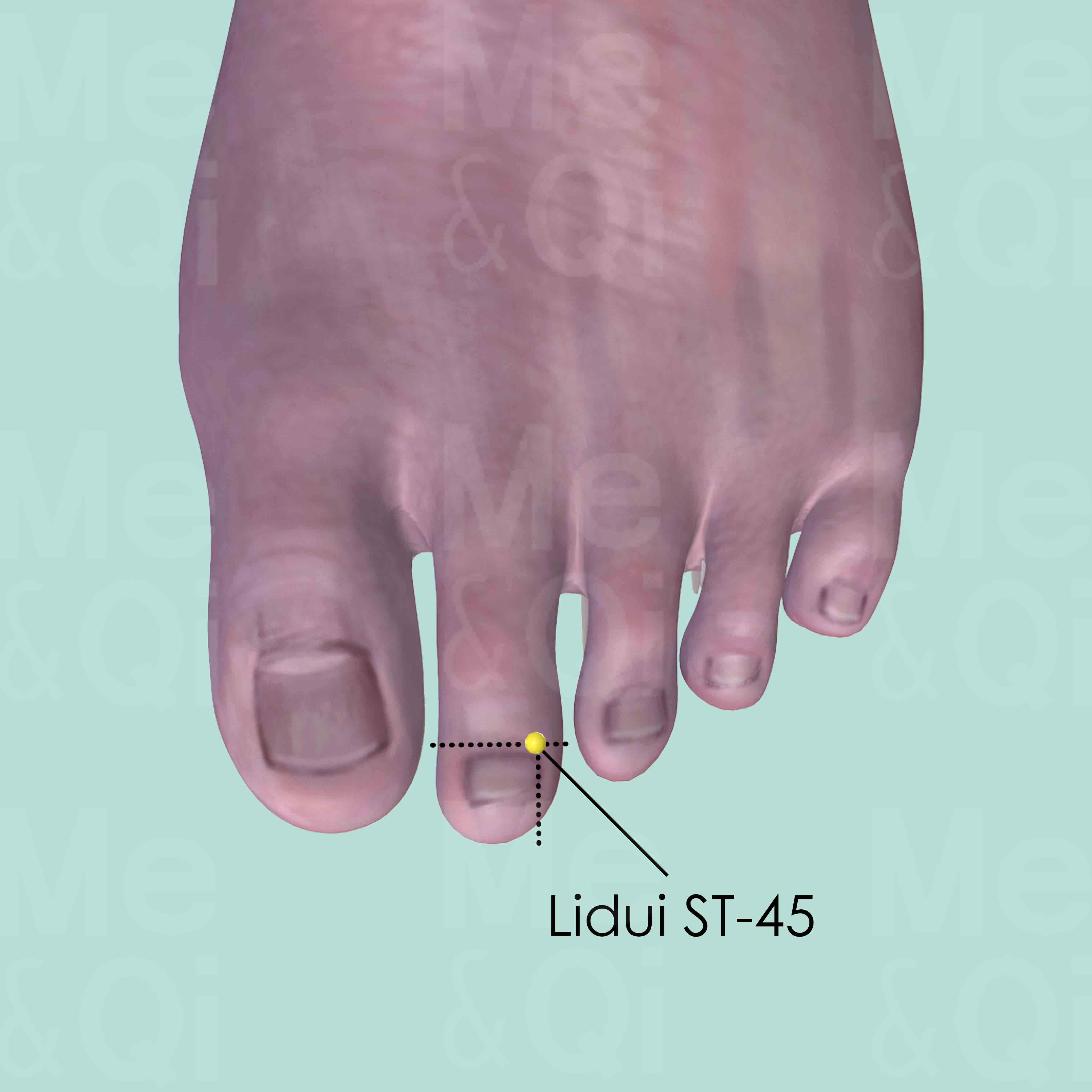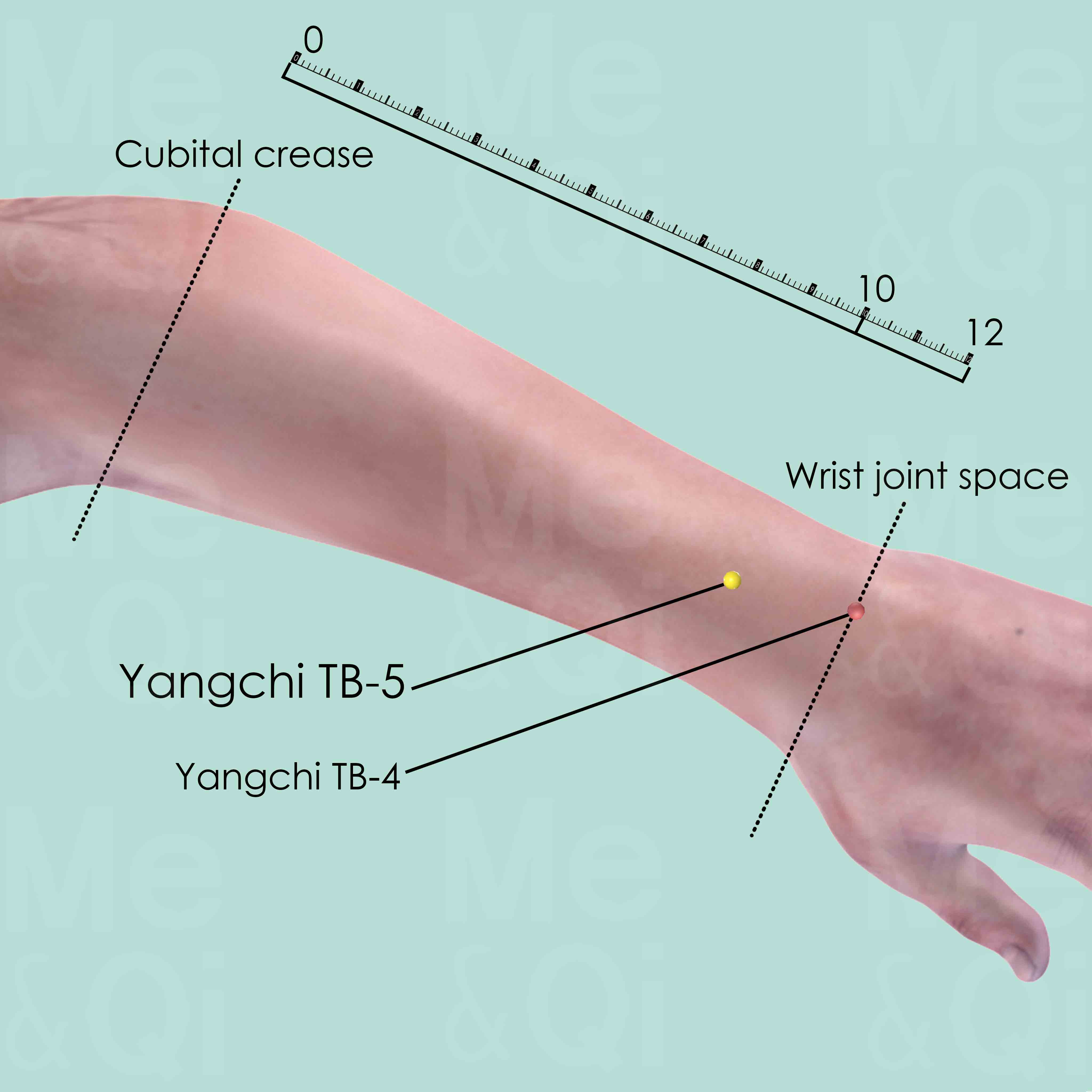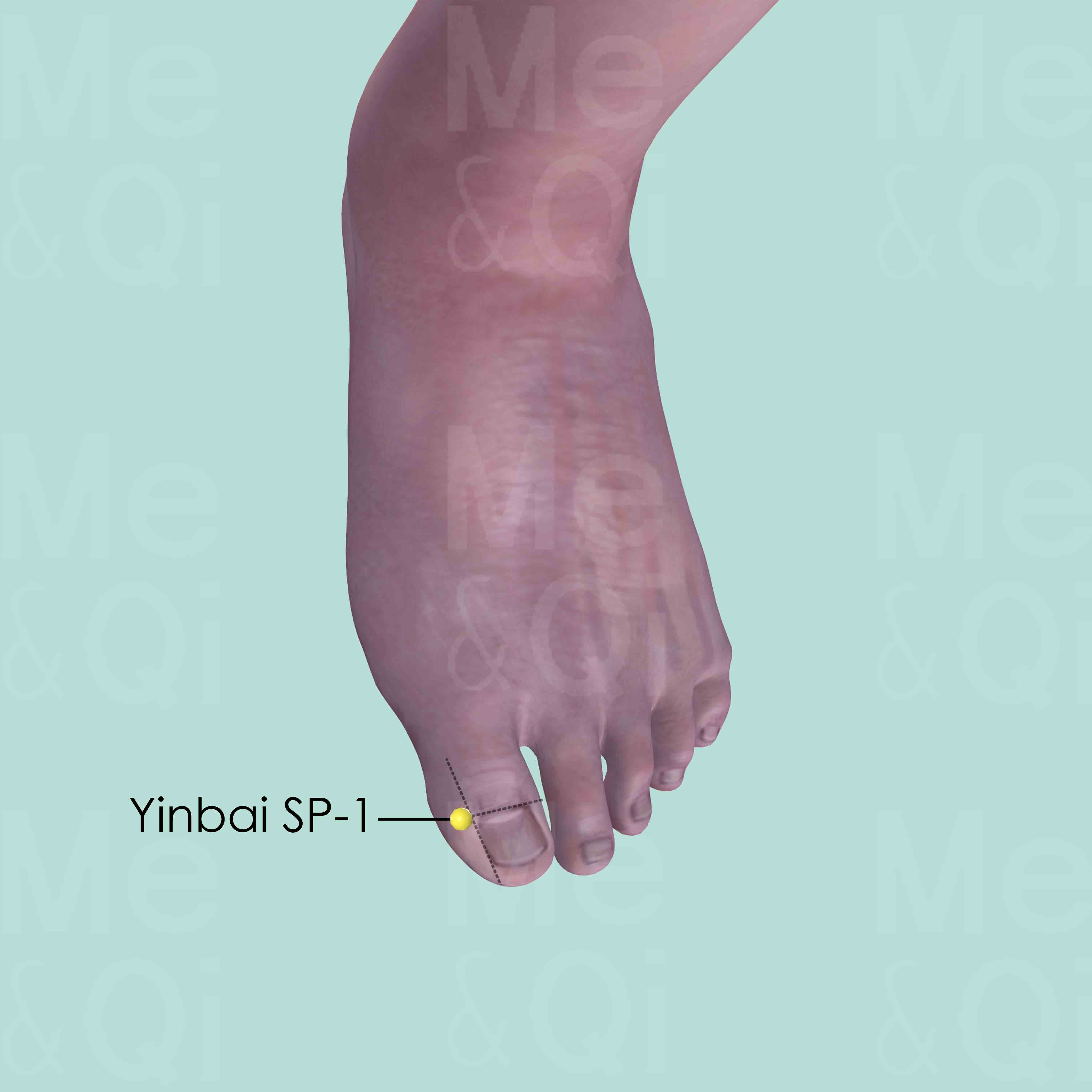Nosebleedsaccording to TCM
Symptom family: Nasal Disorders and Symptoms
Sub-symptom(s): Frequent Nosebleeds
Root Causes of Nosebleeds in TCM
Explore below more details about what might cause Nosebleeds according to TCM.
- By Syndrome
- By Organ
- Heat
- Wind
- Mind Disturbance
- Blood Stasis
- Blood Deficiency
- Cold
- View More Causes
- Liver
Heat
In TCM "Heat" signifies an excess of Yang energy, leading to an imbalance where heat predominates over the body's cool Yin aspects. This condition is metaphorically akin to an internal over-heating. Symptoms indicative of Heat can include feelings of warmth, fever, sweating, irritability, red face, thirst with a preference for cold drinks, and a rapid pulse. The tongue may appear red with a yellow coating. Unlike the common interpretation of heat in terms of temperature, in TCM, it represents a state of hyperactivity or inflammation in the body.... see more
Heat Patterns That Can Lead to Nosebleeds
Common Symptoms: Thirst Vomiting Blood Hemoptysis Irritability Flushed Face Dark Urine Dry Stools Bitter Taste In The Mouth
| Pattern Name | Relevant Symptoms | Relevant Formulas |
|---|---|---|
| Heat in the Blood | Bloody nose, Feeling hot, Red skin eruptions, Thirst, Frequent bleeding, Bloody sputum, Hematochezia, Hematuria, Vomiting blood, Hemoptysis, Nosebleeds, Excessive menstruation... see more | Xi Jiao Di Huang Tang | Gu Jing Wan | Shi Hui San | Bai He Di Huang Tang | Hua Ban Tang | Qing Ying Tang | Qing Re Gu Jing Tang |
| Heat victorious agitating Blood | Epistaxis, Restlessness, High fever, Mania, Macules, Vomiting blood, Nosebleeds, Hematochezia, Hematuria... see more | Xi Jiao Di Huang Tang |
| Liver Fire Blazing | Epistaxis, Irritability, Anger, Tinnitus, Deafness, Temporal headache, Dizziness, Flushed face, Eye hyperemia, Thirst, Bitter taste in the mouth, Vivid dreaming, Constipation, Dry stools, Dark urine, Nosebleeds, Hemoptysis, Vomiting blood... see more | Long Dan Xie Gan Tang | Dang Gui Long Hui Wan | Xie Qing Wan |
| Liver Wind agitating Internally due to Liver Fire | Epistaxis, Tremors, Irritability, Anger, Tinnitus, Deafness, Temporal headache, Dizziness, Flushed face, Eye hyperemia, Thirst, Bitter taste in the mouth, Vivid dreaming, Constipation, Dry stools, Dark urine, Nosebleeds, Vomiting blood, Hemoptysis... see more | Ling Jiao Gou Teng Tang | Zi Xue Dan | Feng Yin Tang |
| Wind Cold with Internal Heat | Nosebleeds, Strong fever, Severe chills, Lack of sweating, Headaches, Feeling of heaviness, General sensation of tightness, Flushed face, Eye hyperemia, Dry nose, Thirst, Irritability, Insomnia, Hemoptysis, Mottled skin... see more | Shi Gao Tang |
Wind
In TCM "Wind" is a concept that represents a pattern of disharmony, often characterized by its sudden and unpredictable nature, much like a gusty wind changing direction without warning. This pattern is associated with symptoms that come and go quickly or move around the body, such as itching, tremors, or even certain types of pain. Wind is considered to be a primary cause of illnesses that have these rapidly changing characteristics. In TCM, external Wind often refers to illnesses that start suddenly, like the common cold, believed to be caused by external pathogenic factors like climatic changes. On the other hand, internal Wind can be linked to internal imbalances and can manifest in conditions like dizziness or spasms. ... see more
Wind Patterns That Can Lead to Nosebleeds
Common Symptoms: Irritability Flushed Face Eye Hyperemia Thirst Hemoptysis Tremors Anger Tinnitus
| Pattern Name | Relevant Symptoms | Relevant Formulas |
|---|---|---|
| Liver Wind agitating Internally due to Liver Fire | Epistaxis, Tremors, Irritability, Anger, Tinnitus, Deafness, Temporal headache, Dizziness, Flushed face, Eye hyperemia, Thirst, Bitter taste in the mouth, Vivid dreaming, Constipation, Dry stools, Dark urine, Nosebleeds, Vomiting blood, Hemoptysis... see more | Ling Jiao Gou Teng Tang | Zi Xue Dan | Feng Yin Tang |
| Wind Cold with Internal Heat | Nosebleeds, Strong fever, Severe chills, Lack of sweating, Headaches, Feeling of heaviness, General sensation of tightness, Flushed face, Eye hyperemia, Dry nose, Thirst, Irritability, Insomnia, Hemoptysis, Mottled skin... see more | Shi Gao Tang |
Mind Disturbance
In TCM "Shen" refers to the mind or spirit, and a Shen disturbance is a pattern of disharmony that affects the mental and emotional state. This concept reflects the TCM belief in the deep interconnectedness of mind and body. Symptoms of Shen disturbance can vary widely but often include anxiety, insomnia, restlessness, confusion, or in severe cases, hallucinations or delirium. These symptoms indicate an imbalance in the body's energies affecting the heart, which in TCM is not only the center of blood circulation but also the seat of the mind and consciousness. The root of Shen disturbance can be traced to various factors, including emotional stress, physical illness, or an imbalance in fundamental substances like Qi, Yin, or Yang.... see more
Mind Disturbance Patterns That Can Lead to Nosebleeds
| Pattern Name | Relevant Symptoms | Relevant Formulas |
|---|---|---|
| Heat victorious agitating Blood | Epistaxis, Restlessness, High fever, Mania, Macules, Vomiting blood, Nosebleeds, Hematochezia, Hematuria... see more | Xi Jiao Di Huang Tang |
Blood Stasis
Blood Stasis in TCM is a concept where the blood flow in the body is not as smooth or efficient as it should be. Imagine a river that's supposed to flow freely, but instead, it's getting blocked or moving too slowly in some parts. This can lead to various health issues, like pain that feels sharp or stabbing, dark bruises, and a complexion that looks purplish. TCM believes that good health relies on the smooth and vibrant flow of Qi and blood throughout the body, so when blood gets stuck, it's like a traffic jam in your body, leading to discomfort or health problems.... see more
Blood Stasis Patterns That Can Lead to Nosebleeds
| Pattern Name | Relevant Symptoms | Relevant Formulas |
|---|---|---|
| Liver Blood Stagnation | Epistaxis, Hypochondriac pain, Abdominal pain, Vomiting blood, Nosebleeds, Menstrual cramps, Irregular periods, Dark menstrual clots, Infertility, Abdominal masses, Purple nails, Purple lips, Purple face, Skin dryness, Petechiae... see more | Xiao Yao San | Chai Hu Shu Gan San | Ge Xia Zhu Yu Tang | Shi Xiao San |
Blood Deficiency
Blood Deficiency in TCM is like when your body's tank runs low on the vital energy that blood provides. It's not exactly the same as anemia in modern medicine, which is about having too few red blood cells. Instead, Blood Deficiency in TCM is about your body not having enough of the life-giving qualities that blood brings, like nourishment and moisture. This can make you feel tired, look pale, and even feel dizzy or have blurry vision. It's like a garden not getting enough water to stay lush and vibrant. TCM sees this as an imbalance where the body isn't being nourished as it should be, impacting overall health and well-being.... see more
Blood Deficiency Patterns That Can Lead to Nosebleeds
| Pattern Name | Relevant Symptoms | Relevant Formulas |
|---|---|---|
| Loss of Blood | Epistaxis, Nosebleeds, Uterine hemorrhage, Hematuria, Hematochezia, Hemoptysis, Vomiting blood, Dark menstrual clots, Excessive menstruation, Bloody sputum... see more | Xi Jiao Di Huang Tang |
Cold
In TCM "Cold" as a pattern of disharmony refers to a specific type of imbalance within the body's systems, often linked to a deficiency or weakness. It's not about feeling physically cold or having a common cold, but rather a metaphorical description of certain symptoms and underlying conditions. When a TCM practitioner says someone suffers from "Cold," it usually implies that the body's Yang energy, which is warm and active, is insufficient or overpowered by Yin energy, which is cool and passive. Symptoms of Cold in TCM can include a general feeling of coldness, cold limbs, pale complexion, low energy, slow metabolism, and a preference for warmth. ... see more
Cold Patterns That Can Lead to Nosebleeds
| Pattern Name | Relevant Symptoms | Relevant Formulas |
|---|---|---|
| Wind Cold with Internal Heat | Nosebleeds, Strong fever, Severe chills, Lack of sweating, Headaches, Feeling of heaviness, General sensation of tightness, Flushed face, Eye hyperemia, Dry nose, Thirst, Irritability, Insomnia, Hemoptysis, Mottled skin... see more | Shi Gao Tang |
Liver
In TCM the Liver is viewed as the organ responsible for the smooth flow of Qi, Blood, and emotions throughout the body. It plays a key role in regulating mood, storing blood, supporting digestion, and ensuring the health of tendons and eyes. When the Liver malfunctions or is imbalanced in TCM, it can lead to a range of issues such as irritability, mood swings, menstrual irregularities, eye problems, and muscular stiffness or pain. A malfunctioning Liver in TCM reflects not only physical disturbances but also emotional and mental disharmony, emphasizing the holistic approach of TCM in addressing health and wellness.... see more
Liver Patterns That Can Lead to Nosebleeds
Common Symptoms: Vomiting Blood Irritability Anger Tinnitus Deafness Temporal Headache Dizziness Flushed Face
| Pattern Name | Relevant Symptoms | Relevant Formulas |
|---|---|---|
| Liver Blood Stagnation | Epistaxis, Hypochondriac pain, Abdominal pain, Vomiting blood, Nosebleeds, Menstrual cramps, Irregular periods, Dark menstrual clots, Infertility, Abdominal masses, Purple nails, Purple lips, Purple face, Skin dryness, Petechiae... see more | Xiao Yao San | Chai Hu Shu Gan San | Ge Xia Zhu Yu Tang | Shi Xiao San |
| Liver Fire Blazing | Epistaxis, Irritability, Anger, Tinnitus, Deafness, Temporal headache, Dizziness, Flushed face, Eye hyperemia, Thirst, Bitter taste in the mouth, Vivid dreaming, Constipation, Dry stools, Dark urine, Nosebleeds, Hemoptysis, Vomiting blood... see more | Long Dan Xie Gan Tang | Dang Gui Long Hui Wan | Xie Qing Wan |
| Liver Wind agitating Internally due to Liver Fire | Epistaxis, Tremors, Irritability, Anger, Tinnitus, Deafness, Temporal headache, Dizziness, Flushed face, Eye hyperemia, Thirst, Bitter taste in the mouth, Vivid dreaming, Constipation, Dry stools, Dark urine, Nosebleeds, Vomiting blood, Hemoptysis... see more | Ling Jiao Gou Teng Tang | Zi Xue Dan | Feng Yin Tang |
TCM Herbal Formulas for Nosebleeds
Explore below some TCM herbal formulas used to address nosebleeds, organized by cause and by formula type.
- By Cause
- By Formula Type
- Heat
- Wind
- Mind Disturbance
- Blood Stasis
- Blood Deficiency
- Cold
- View More Causes
- Formulas that clear heat from the organs
- Formulas that clear nutritive-level heat
- Formulas that clear heat from deficiency
- Formulas that invigorate blood and dispel blood stagnation
- Formulas that secure irregular uterine bleeding and stop vaginal discharge
- Formulas that stop bleeding
- Formulas that clear heat from qi and blood
- Formulas that warm interior cold
- Formulas that harmonize liver-Spleen
- Formulas that promote qi movement
- Formulas that pacify and extinguish internal wind
- Formulas that clear heat and open sensory orifices
- Formulas that dredge and disperse external wind
- Formulas that tonify qi
- Formulas that clear qi-level heat
- Formulas that release the exterior and clear the interior
- Formulas that tonify blood
Top Formula for Heat:
Xi Jiao Di Huang Tang
Suitable for Heat patterns that may cause nosebleeds, such as Heat in the Blood or Heat victorious agitating Blood
Learn moreAll Formulas Recommended for Nosebleeds Caused by Heat
| Formula | Patterns Suitable For |
|---|---|
| Xi Jiao Di Huang Tang | Heat in the Blood, Heat victorious agitating Blood |
| Gu Jing Wan | Heat in the Blood |
| Shi Hui San | Heat in the Blood |
| Bai He Di Huang Tang | Heat in the Blood |
| Hua Ban Tang | Heat in the Blood |
| Qing Ying Tang | Heat in the Blood |
| Qing Re Gu Jing Tang | Heat in the Blood |
| Long Dan Xie Gan Tang | Liver Fire Blazing |
| Dang Gui Long Hui Wan | Liver Fire Blazing |
| Xie Qing Wan | Liver Fire Blazing |
| Ling Jiao Gou Teng Tang | Liver Wind agitating Internally due to Liver Fire |
| Zi Xue Dan | Liver Wind agitating Internally due to Liver Fire |
| Feng Yin Tang | Liver Wind agitating Internally due to Liver Fire |
| Shi Gao Tang | Wind Cold with Internal Heat |
Top Formula for Wind:
Ling Jiao Gou Teng Tang
Suitable for Wind patterns that may cause nosebleeds, such as Liver Wind agitating Internally due to Liver Fire
Learn moreAll Formulas Recommended for Nosebleeds Caused by Wind
| Formula | Patterns Suitable For |
|---|---|
| Ling Jiao Gou Teng Tang | Liver Wind agitating Internally due to Liver Fire |
| Zi Xue Dan | Liver Wind agitating Internally due to Liver Fire |
| Feng Yin Tang | Liver Wind agitating Internally due to Liver Fire |
| Shi Gao Tang | Wind Cold with Internal Heat |
Top Formula for Mind Disturbance:
Xi Jiao Di Huang Tang
Suitable for Mind Disturbance patterns that may cause nosebleeds, such as Heat victorious agitating Blood
Learn moreTop Formula for Blood Stasis:
Xiao Yao San
Suitable for Blood Stasis patterns that may cause nosebleeds, such as Liver Blood Stagnation
Learn moreAll Formulas Recommended for Nosebleeds Caused by Blood Stasis
| Formula | Patterns Suitable For |
|---|---|
| Xiao Yao San | Liver Blood Stagnation |
| Chai Hu Shu Gan San | Liver Blood Stagnation |
| Ge Xia Zhu Yu Tang | Liver Blood Stagnation |
| Shi Xiao San | Liver Blood Stagnation |
Top Formula for Blood Deficiency:
Xi Jiao Di Huang Tang
Suitable for Blood Deficiency patterns that may cause nosebleeds, such as Loss of Blood
Learn moreTop Formula for Cold:
Shi Gao Tang
Suitable for Cold patterns that may cause nosebleeds, such as Wind Cold with Internal Heat
Learn moreFormulas that clear nutritive-level Heat
These formulas are suitable for some nosebleeds-causing patterns like Heat in the Blood or Heat victorious agitating Blood.
One such formula is Xi Jiao Di Huang Tang, with water buffalo horn as a key herb.
Other formulas of this category are listed in the table below.
All "formulas that clear nutritive-level heat" recommended for nosebleeds
| Formula | Patterns Suitable For (if applicable) |
|---|---|
| Xi Jiao Di Huang Tang | Heat in the Blood, Heat victorious agitating Blood, Loss of Blood |
| Qing Ying Tang | Heat in the Blood |
Formulas that clear Heat from the Organs
These formulas are suitable for some nosebleeds-causing patterns like Liver Fire Blazing.
One such formula is Long Dan Xie Gan Tang, with chinese gentian as a key herb.
Other formulas of this category are listed in the table below.
All "formulas that clear heat from the organs" recommended for nosebleeds
| Formula | Patterns Suitable For (if applicable) |
|---|---|
| Long Dan Xie Gan Tang | Liver Fire Blazing |
| Dang Gui Long Hui Wan | Liver Fire Blazing |
| Xie Qing Wan | Liver Fire Blazing |
Formulas that clear Heat from Deficiency
These formulas are suitable for some nosebleeds-causing patterns like Heat in the Blood.
One such formula is Bai He Di Huang Tang, with lily bulb as a key herb.
Other formulas of this category are listed in the table below.
All "formulas that clear heat from deficiency" recommended for nosebleeds
| Formula | Patterns Suitable For (if applicable) |
|---|---|
| Bai He Di Huang Tang | Heat in the Blood |
| Qing Re Gu Jing Tang | Heat in the Blood |
Formulas that invigorate Blood and dispel Blood Stagnation
These formulas are suitable for some nosebleeds-causing patterns like Liver Blood Stagnation.
One such formula is Ge Xia Zhu Yu Tang, with szechuan lovage root as a key herb.
Other formulas of this category are listed in the table below.
All "formulas that invigorate blood and dispel blood stagnation" recommended for nosebleeds
| Formula | Patterns Suitable For (if applicable) |
|---|---|
| Ge Xia Zhu Yu Tang | Liver Blood Stagnation |
| Shi Xiao San | Liver Blood Stagnation |
Formulas that secure irregular uterine bleeding and stop vaginal discharge
These formulas are suitable for some nosebleeds-causing patterns like Heat in the Blood.
One such formula is Gu Jing Wan, with tortoise plastron as a key herb.
Formulas that stop bleeding
These formulas are suitable for some nosebleeds-causing patterns like Heat in the Blood.
One such formula is Shi Hui San, with japanese thistle as a key herb.
Formulas that clear Heat from Qi and Blood
These formulas are suitable for some nosebleeds-causing patterns like Heat in the Blood.
One such formula is Hua Ban Tang, with gypsum as a key herb.
Formulas that harmonize Liver-Spleen
These formulas are suitable for some nosebleeds-causing patterns like Liver Blood Stagnation.
One such formula is Xiao Yao San, with bupleurum root as a key herb.
Formulas that promote Qi movement
These formulas are suitable for some nosebleeds-causing patterns like Liver Blood Stagnation.
One such formula is Chai Hu Shu Gan San, with bupleurum root as a key herb.
Formulas that pacify and extinguish Internal Wind
These formulas are suitable for some nosebleeds-causing patterns like Liver Wind agitating Internally due to Liver Fire.
One such formula is Ling Jiao Gou Teng Tang, with saiga antelope's horns as a key herb.
Formulas that clear Heat and open sensory orifices
These formulas are suitable for some nosebleeds-causing patterns like Liver Wind agitating Internally due to Liver Fire.
One such formula is Zi Xue Dan, with water buffalo horn as a key herb.
Formulas that dredge and disperse External Wind
These formulas are suitable for some nosebleeds-causing patterns like Liver Wind agitating Internally due to Liver Fire.
One such formula is Feng Yin Tang, with dragon bones as a key herb.
Formulas that Release the Exterior and Clear the Interior
These formulas are suitable for some nosebleeds-causing patterns like Wind Cold with Internal Heat.
One such formula is Shi Gao Tang, with gypsum as a key herb.
Formulas that warm Interior Cold
Nosebleeds can be treated by these formulas when it is caused by an internal cold condition, needing treatments that warm the body's interior.
One such formula is Gan Cao Gan Jiang Tang, with dried ginger as a key herb.
Formulas that tonify Qi
Nosebleeds can be treated by these formulas if it results from Qi deficiency, necessitating treatments that boost the body's vital energy.
One such formula is Si Jun Zi Tang, with ginseng as a key herb.
Formulas that clear Qi-level Heat
Nosebleeds can be treated by these formulas when it results from an intense heat condition at the qi level, affecting the body's energy flow.
One such formula is Zhi Zi Chi Tang, with cape jasmine fruit as a key herb.
Formulas that tonify Blood
Nosebleeds can be treated by these formulas when it is due to blood deficiency, requiring blood-nourishing and enriching actions.
One such formula is Shao Yao Gan Cao Tang, with white peony root as a key herb.
Acupoints for Nosebleeds
Explore below some acupoints used to address nosebleeds, organized by meridian.
- By Meridian
- Bladder Channel
- Governing Vessel
- Large Intestine Channel
- Small Intestine Channel
- Gall Bladder Channel
- Stomach Channel
- Triple Burner Channel
- Extra Points: Head and Neck (EX-HN)
- Lung Channel
- Pericardium Channel
- Spleen Channel
- Heart Channel
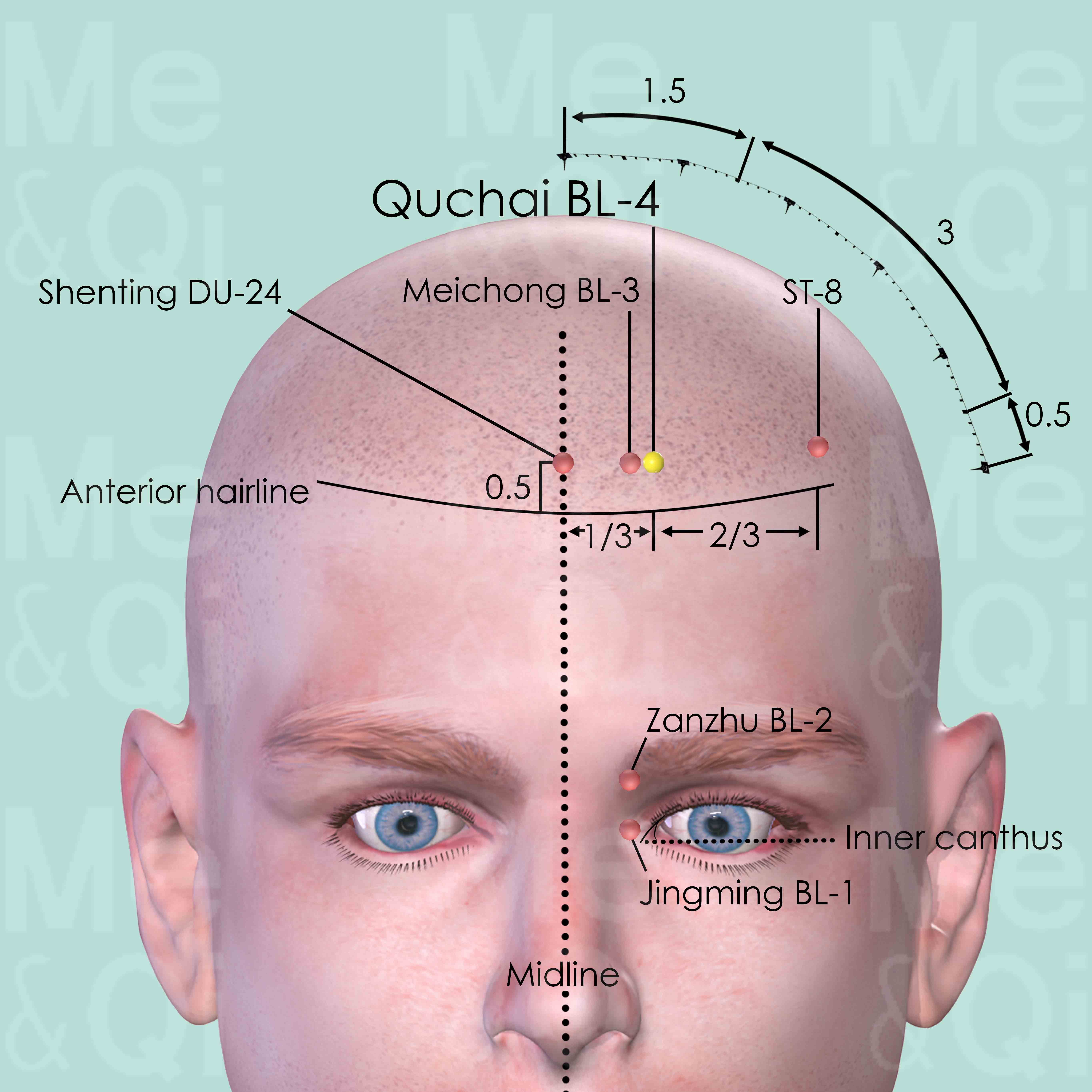
Qucha BL-4
0.5 cun superior to the anterior hairline and 1.5 cun lateral to the anterior midline, at the junction of the medial third and lateral two-thirds of the distance from anterior midline to Touwei ST-8.
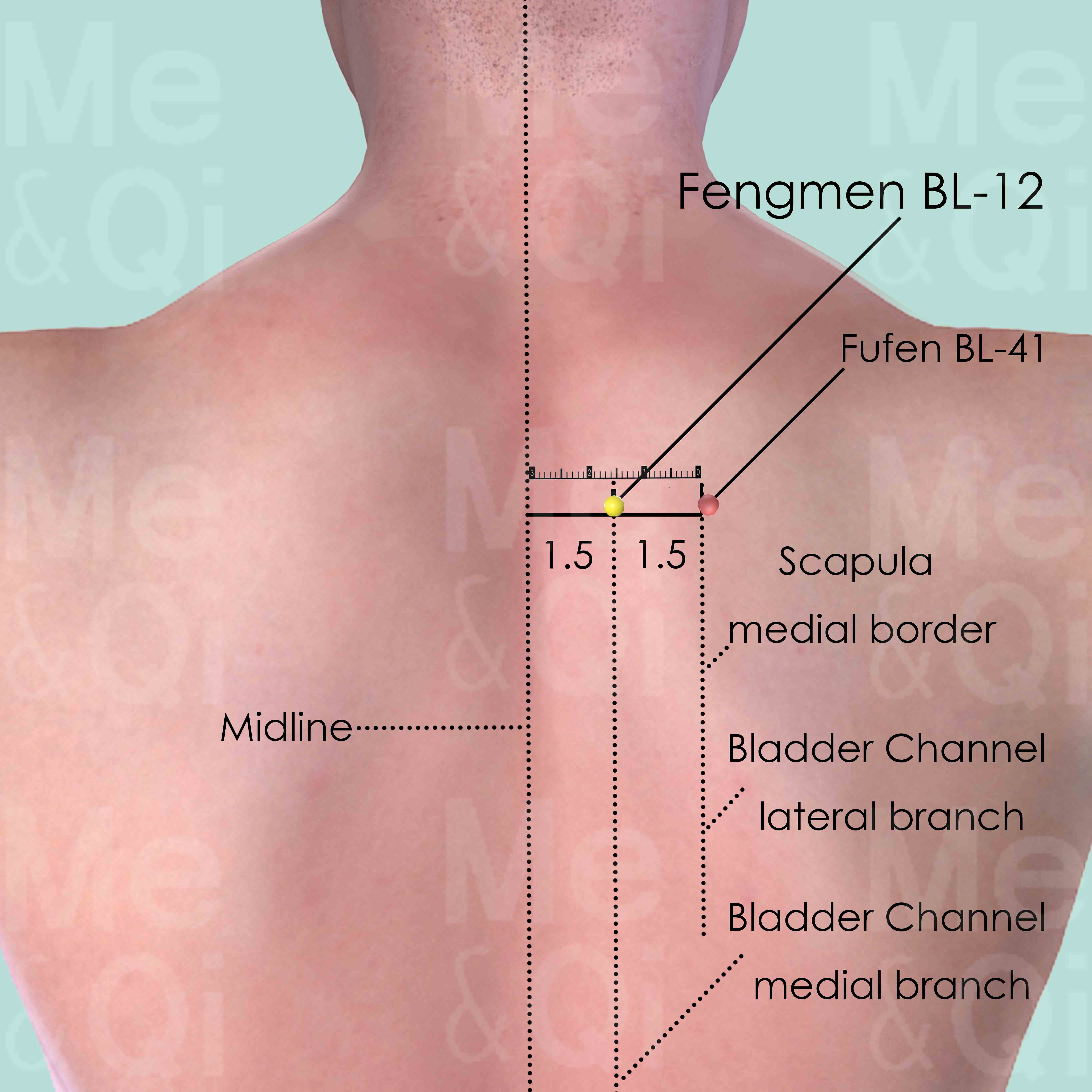
Fengmen BL-12
1.5 cun lateral to the lower border of the spinous process of the 2nd thoracic vertebra (T2).
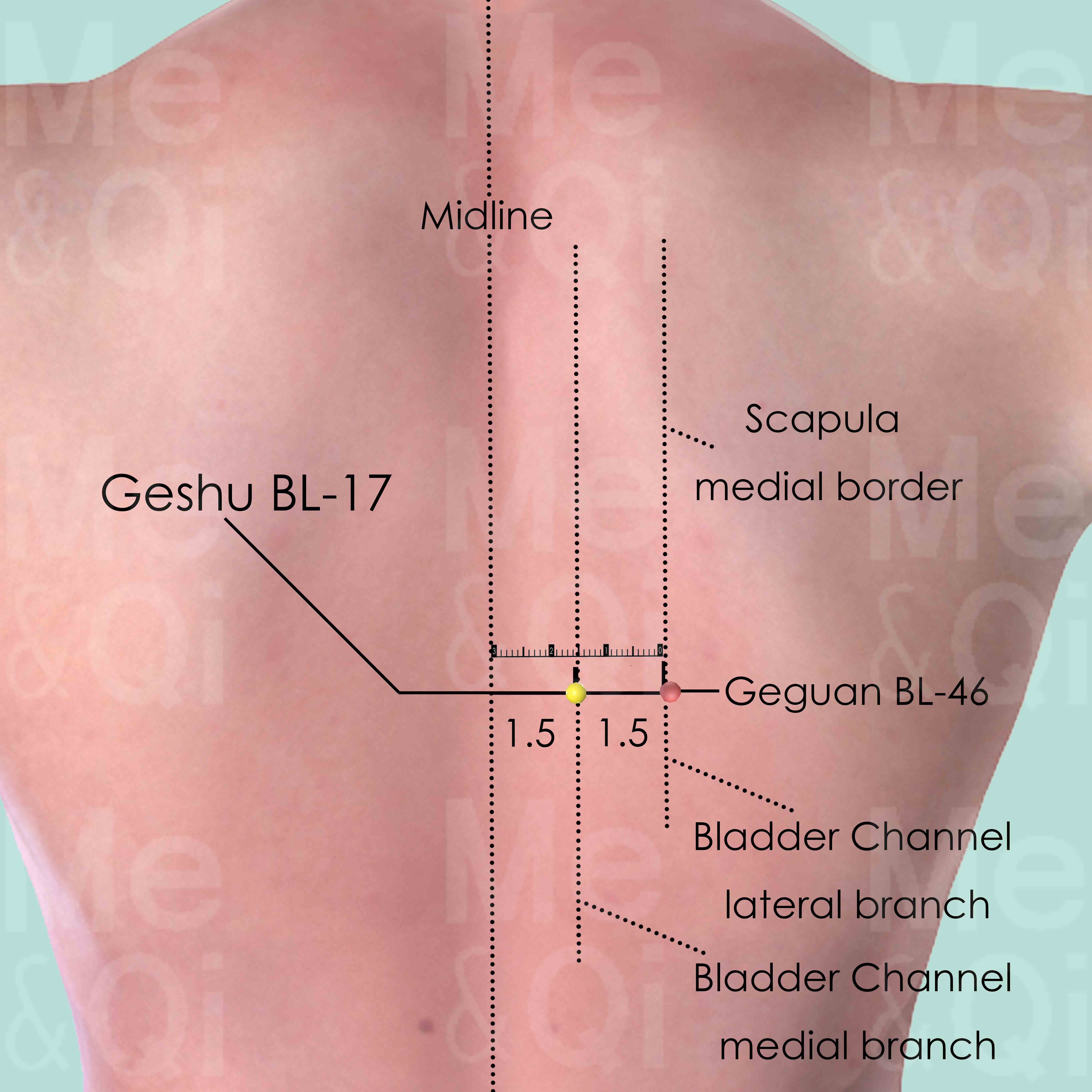
Geshu BL-17
1.5 cun lateral to the lower border of the spinous process of the 7th thoracic vertebra (T7).
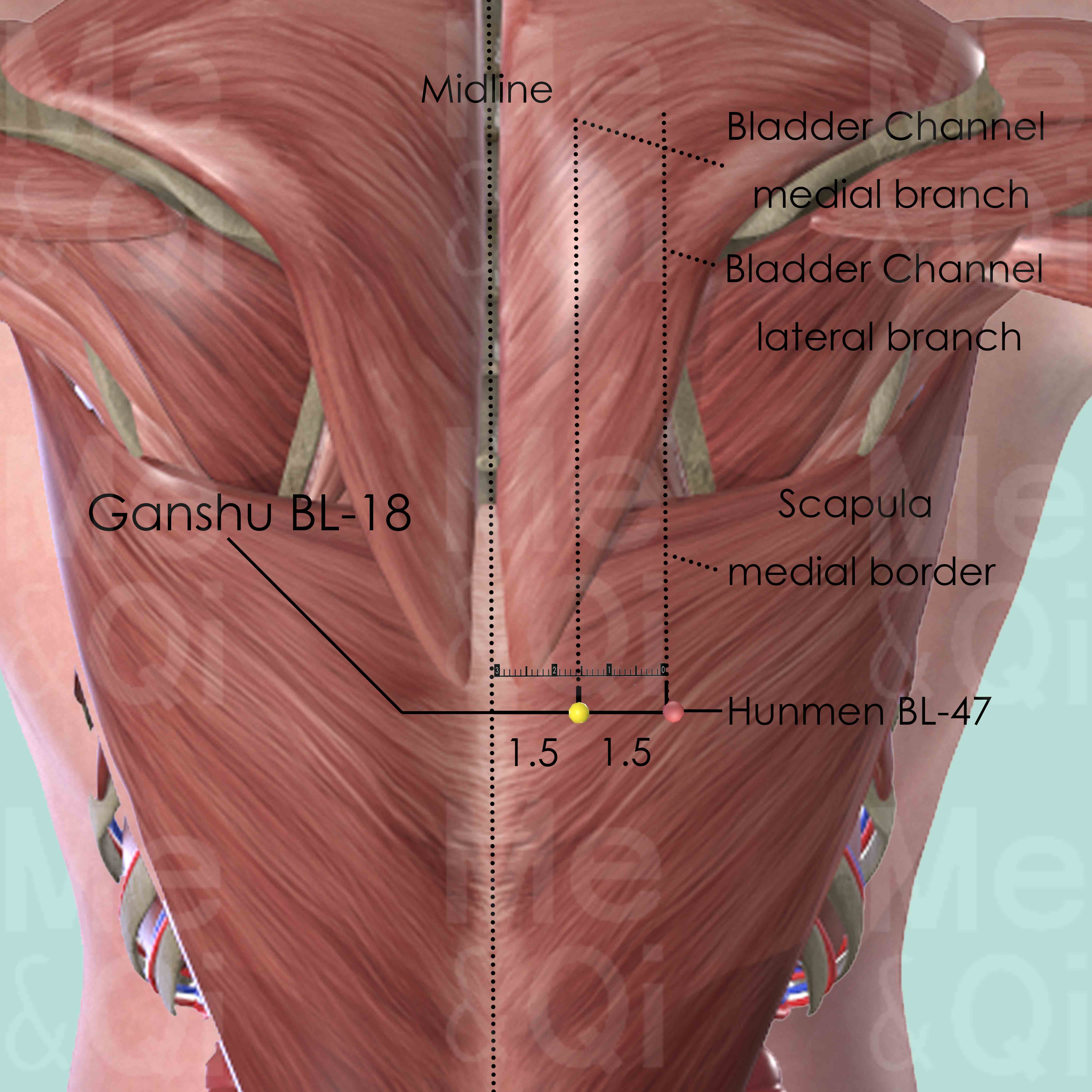
Ganshu BL-18
1.5 cun lateral to the lower border of the spinous process of the 9th thoracic vertebra (T9).
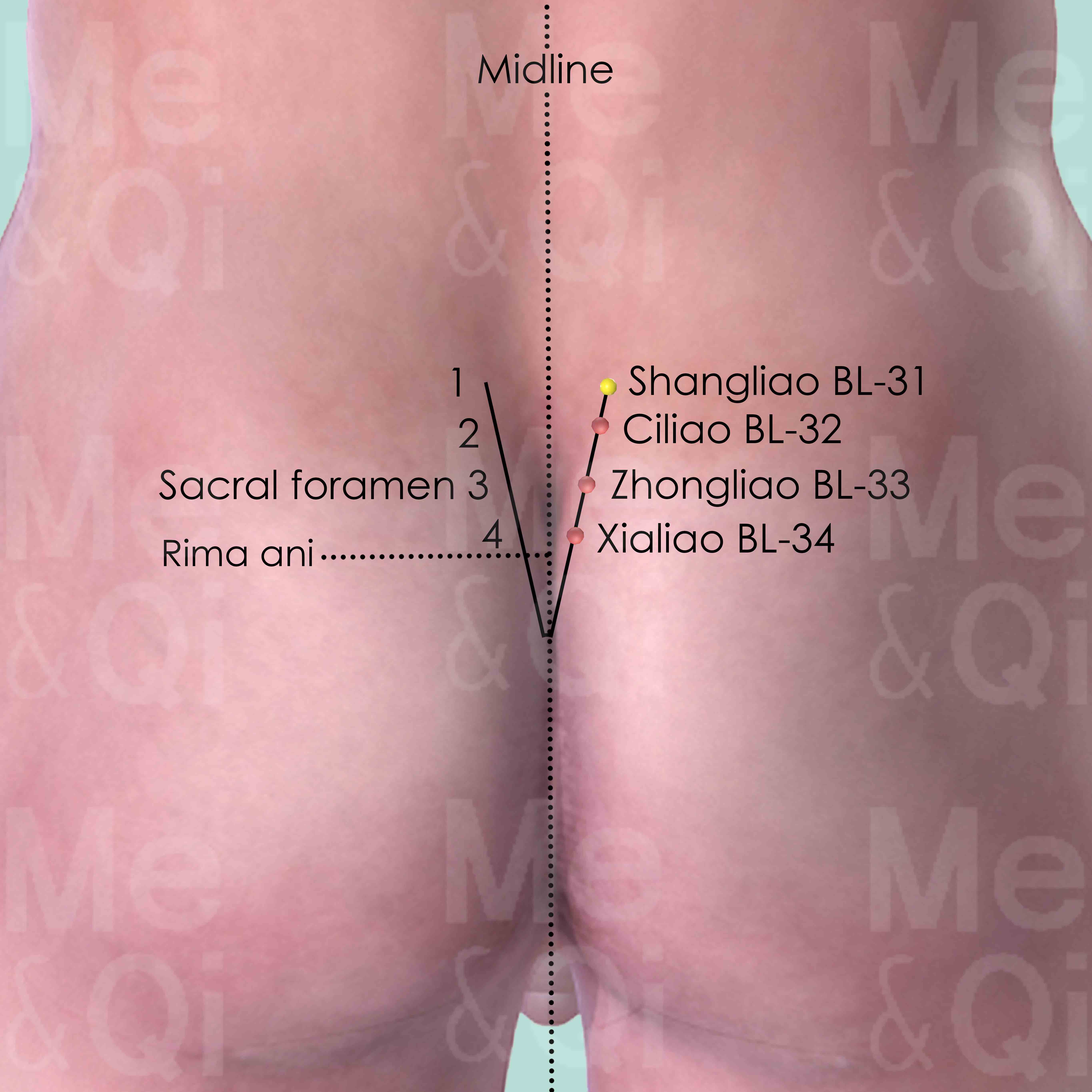
Shangliao BL-31
In the 1st posterior sacral foramen, about midway between the posterior superior iliac spine (PSIS) and the midline.
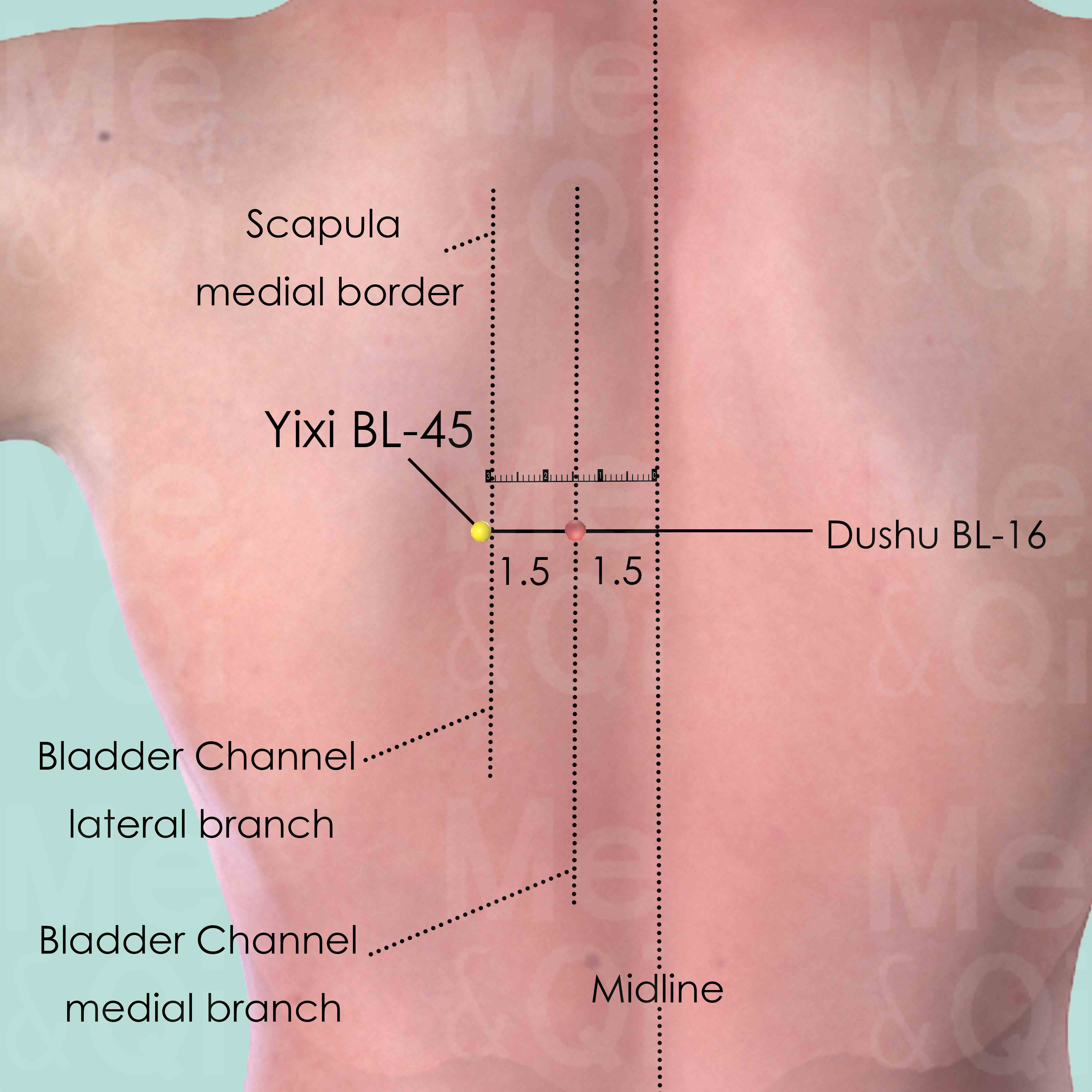
Yixi BL-45
3 cun (about 4 finger-breadths) lateral to the lower border of the spinous process of the 6th thoracic vertebra (T6).
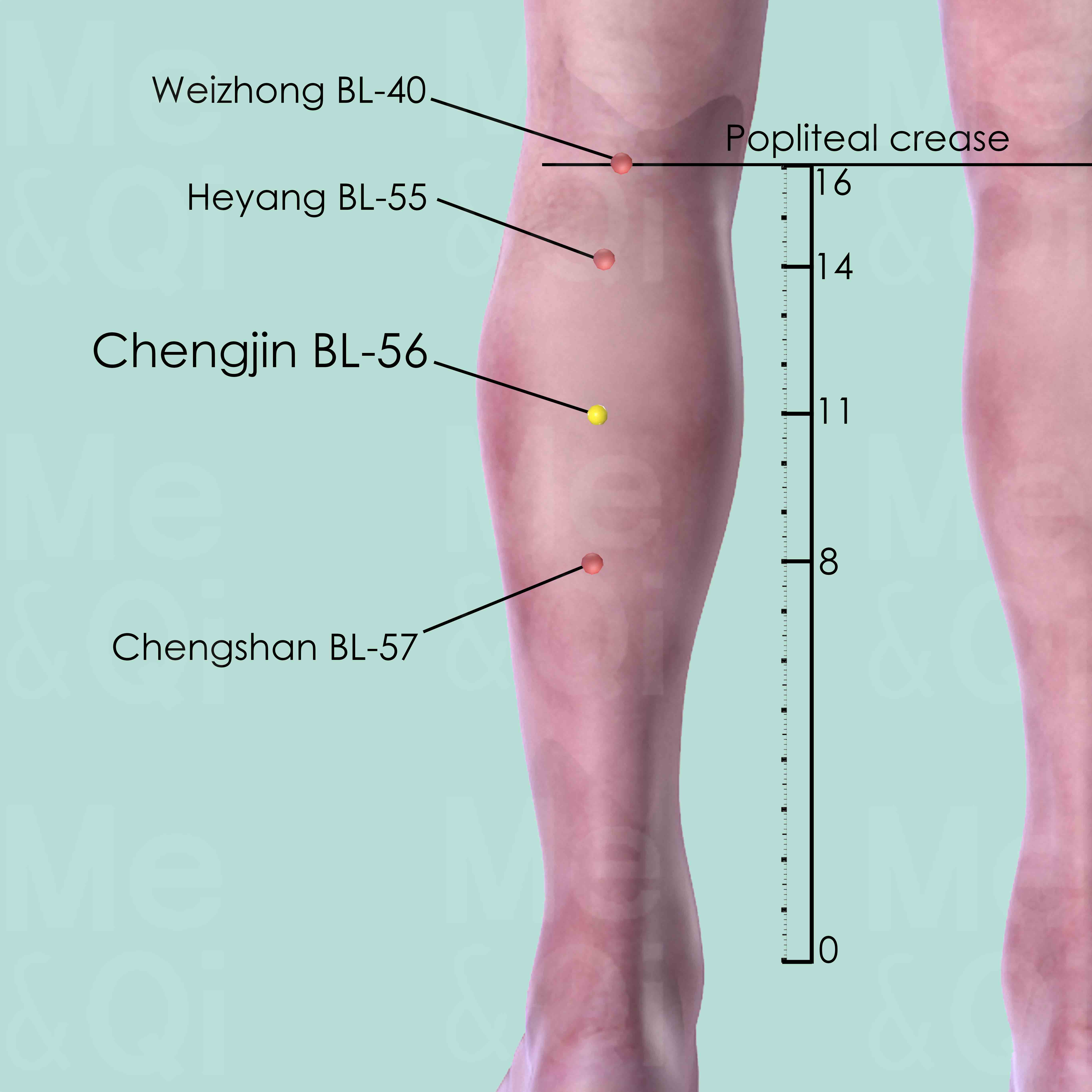
Chengjin BL-56
5 cun inferior to Weizhong BL-40 which is the midpoint of the popliteal crease. In the center of the belly of gastrocnemius muscle, midway between Heyang BL-55 and Chengshan BL-57.
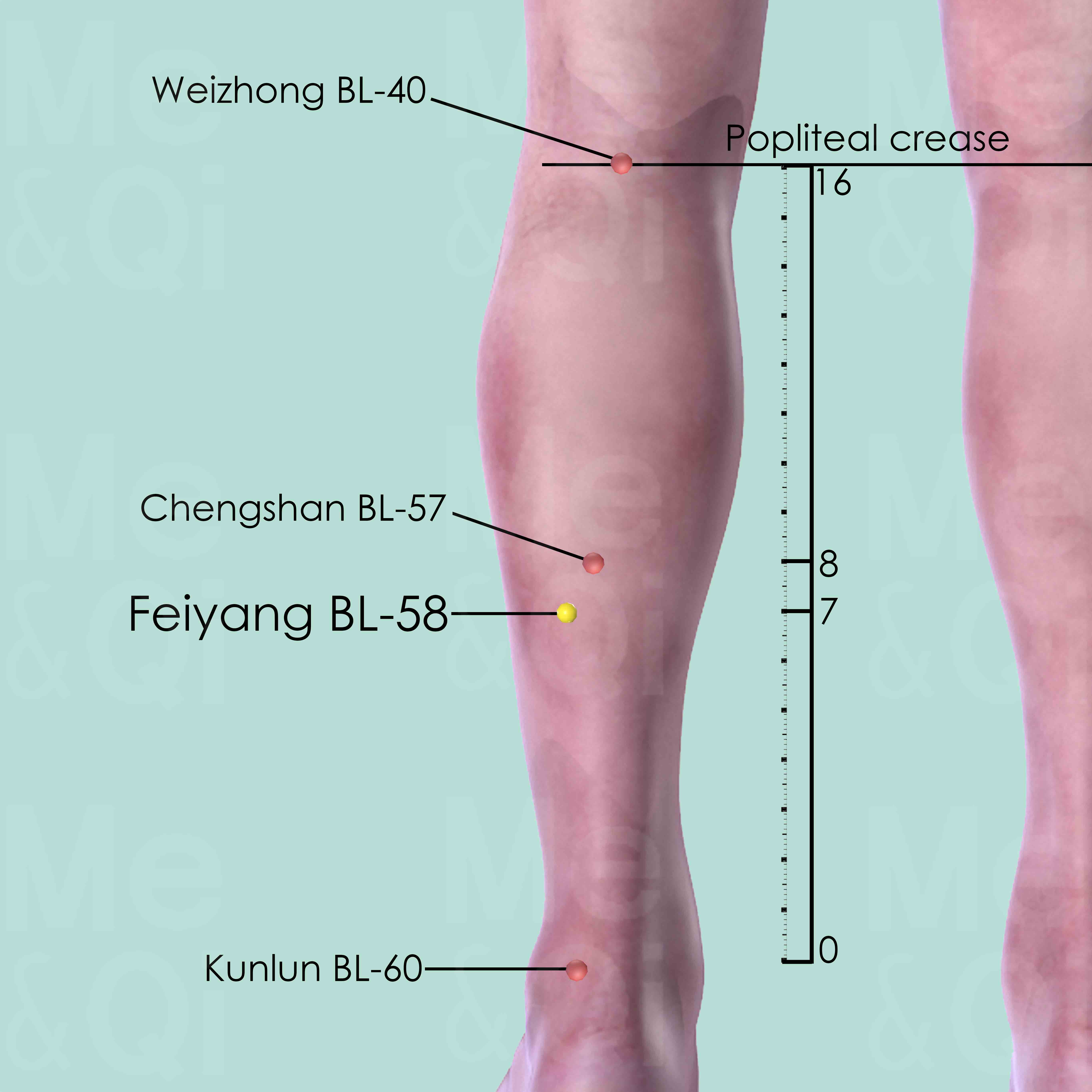
Feiyang BL-58
On the posterior border of fibula, about 1 cun inferior and lateral to Chengshan BL-57, 7 cun directly above Kunlun BL-60.
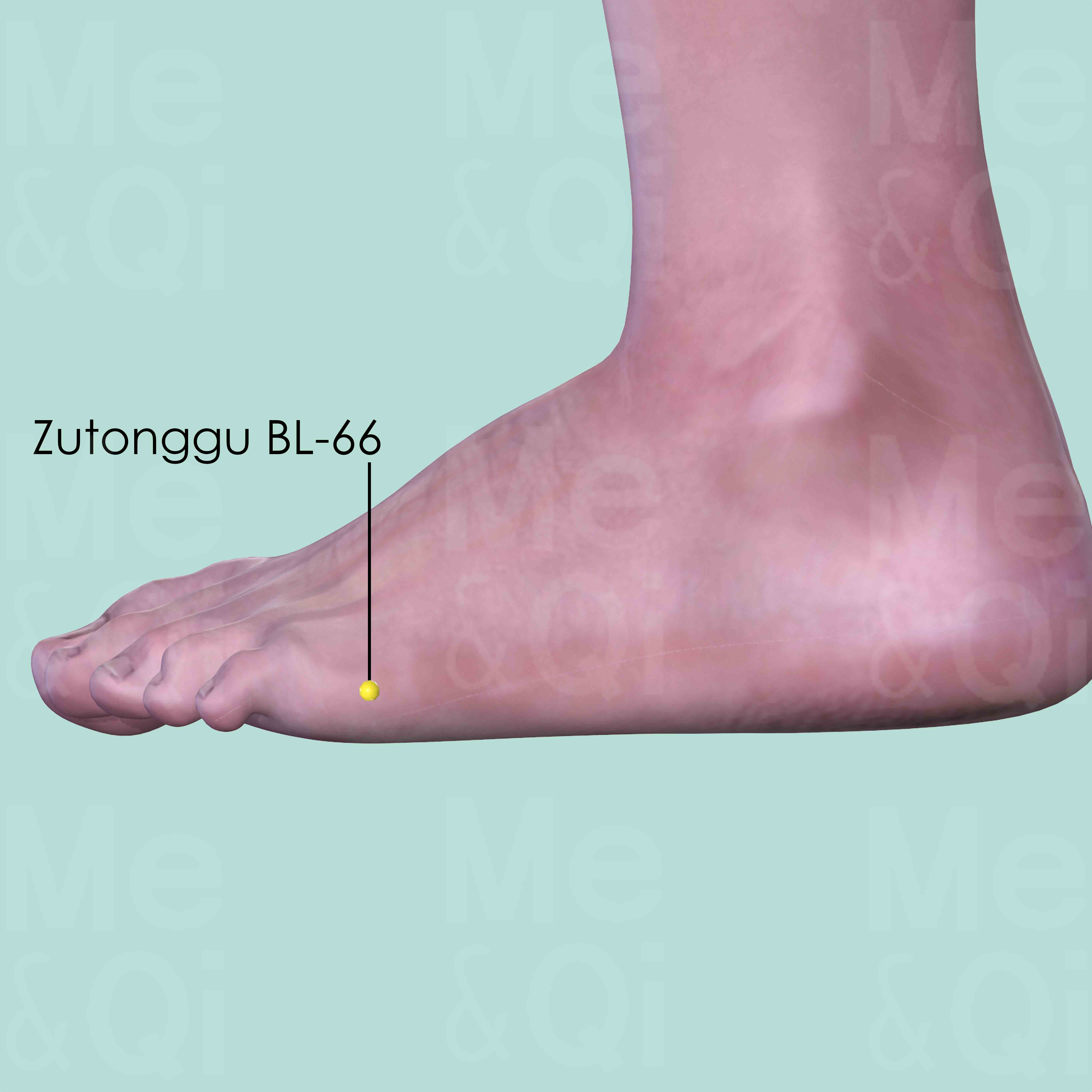
Zutonggu BL-66
In the depression distal and inferior to the 5th metatarsophalangeal joint, at the lateral border of the foot.
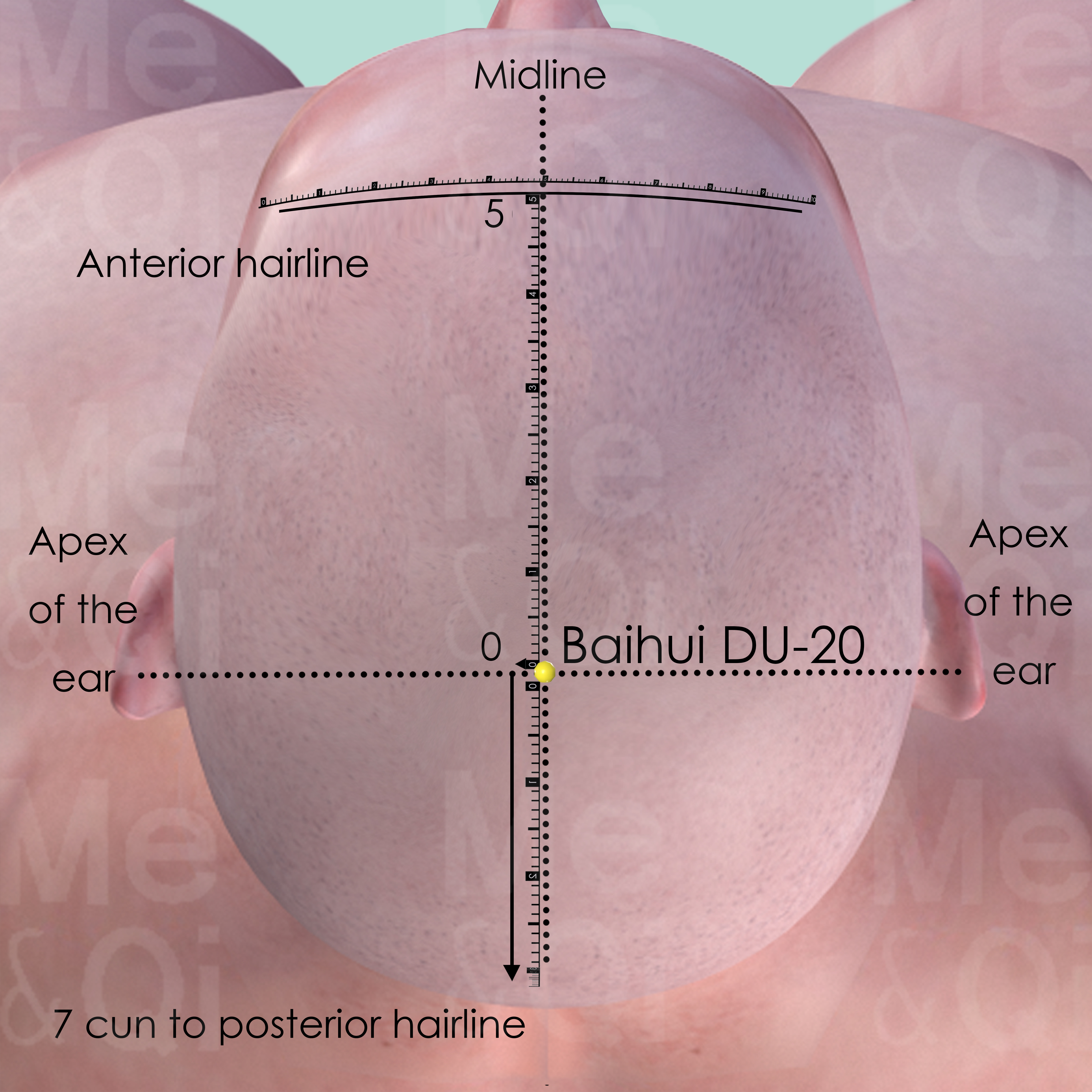
Baihui DU-20
At the vertex, at the junction of a line connecting the apex of the ears and the midline, in the depression 7 cun above the posterior hairline and 5 cun behind the anterior hairline.

Xinhui DU-22
On the head midline, 3 cun anterior to Baihui DU-20, 2 cun posterior to the front hairline.
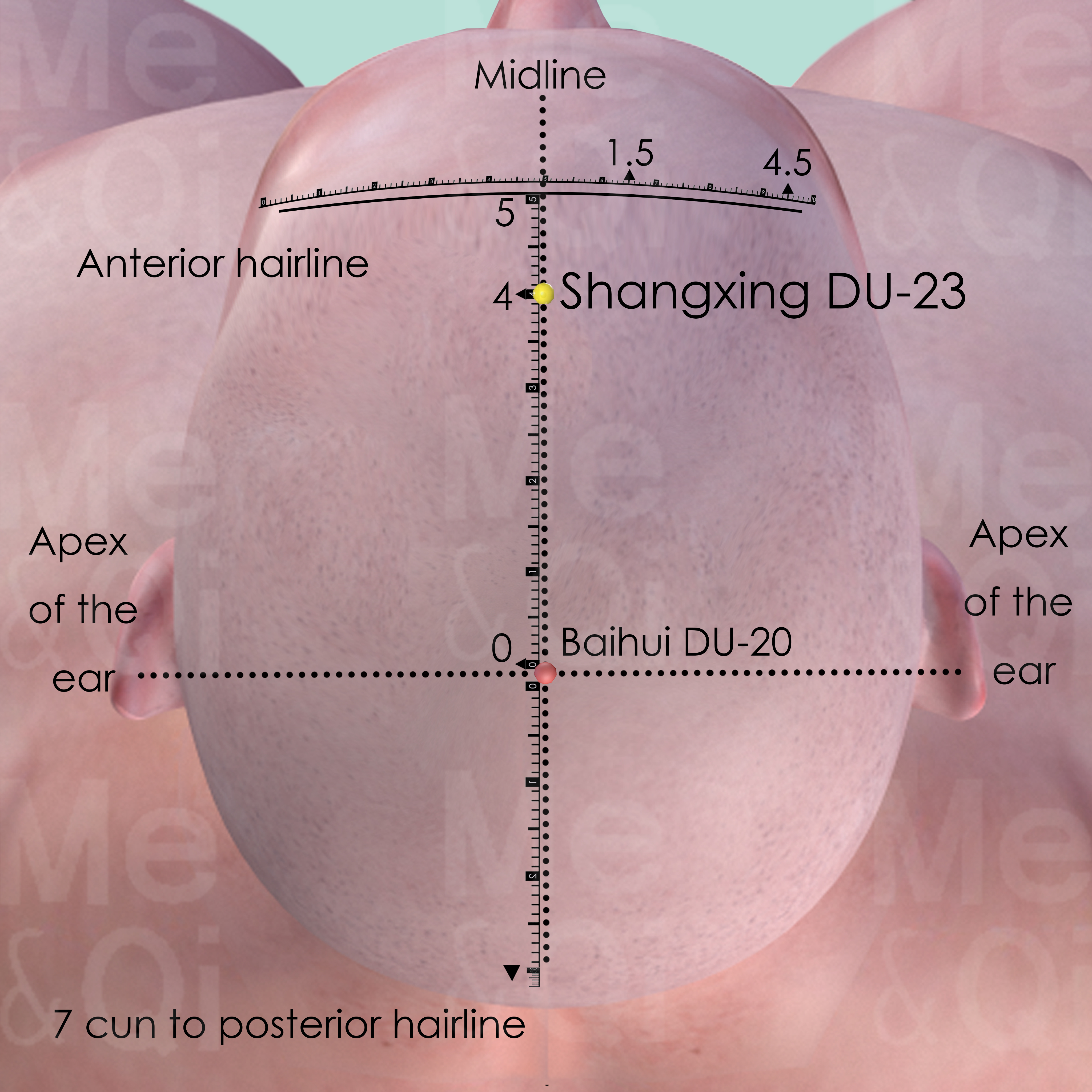
Shangxing DU-23
On the head midline, 1 cun within anterior to the front hairline, 4 cun anterior to Baihui DU-20.
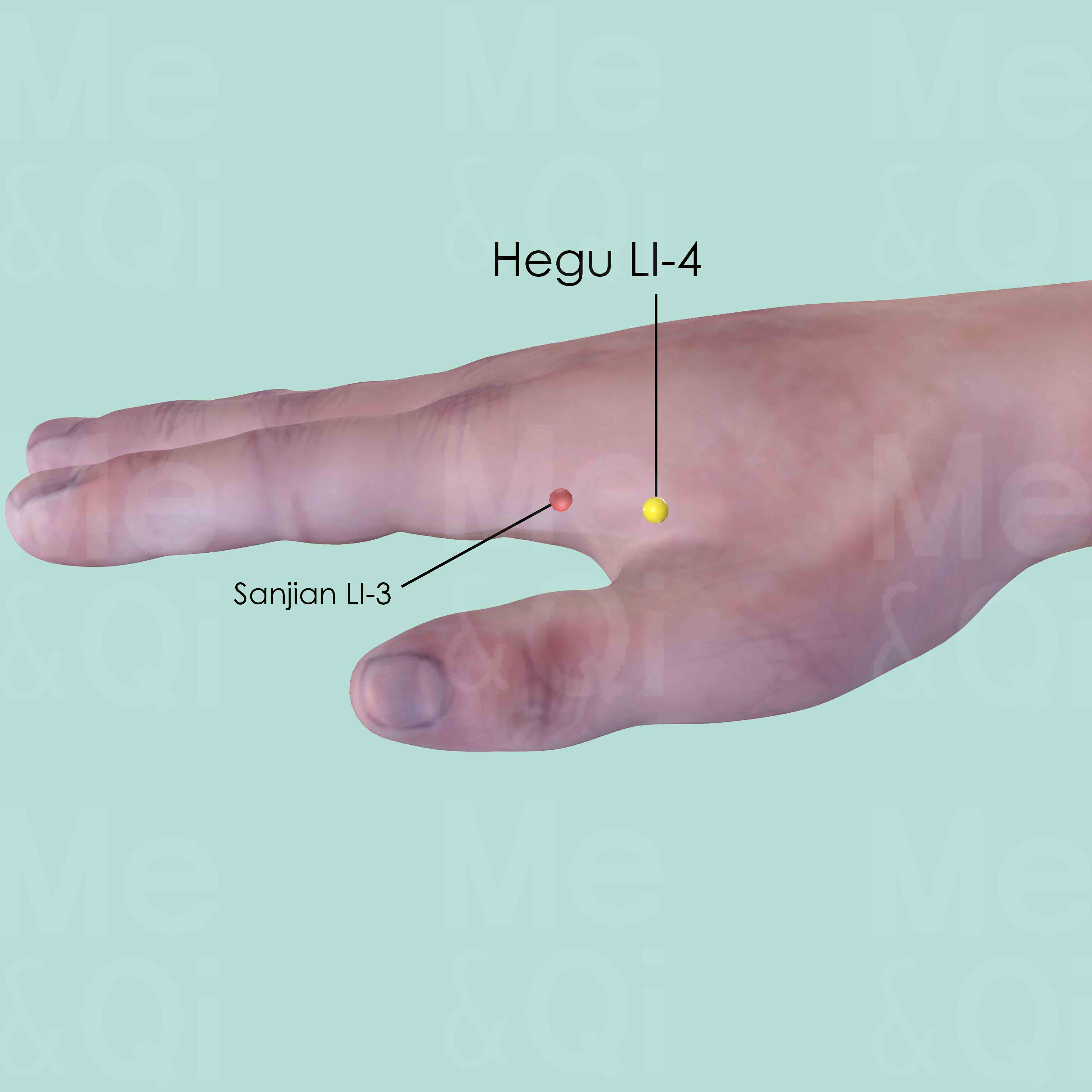
Hegu LI-4
Between the 1st and 2nd metacarpal bones, approximately in the middle of the 2nd metacarpal bone on the radial side.
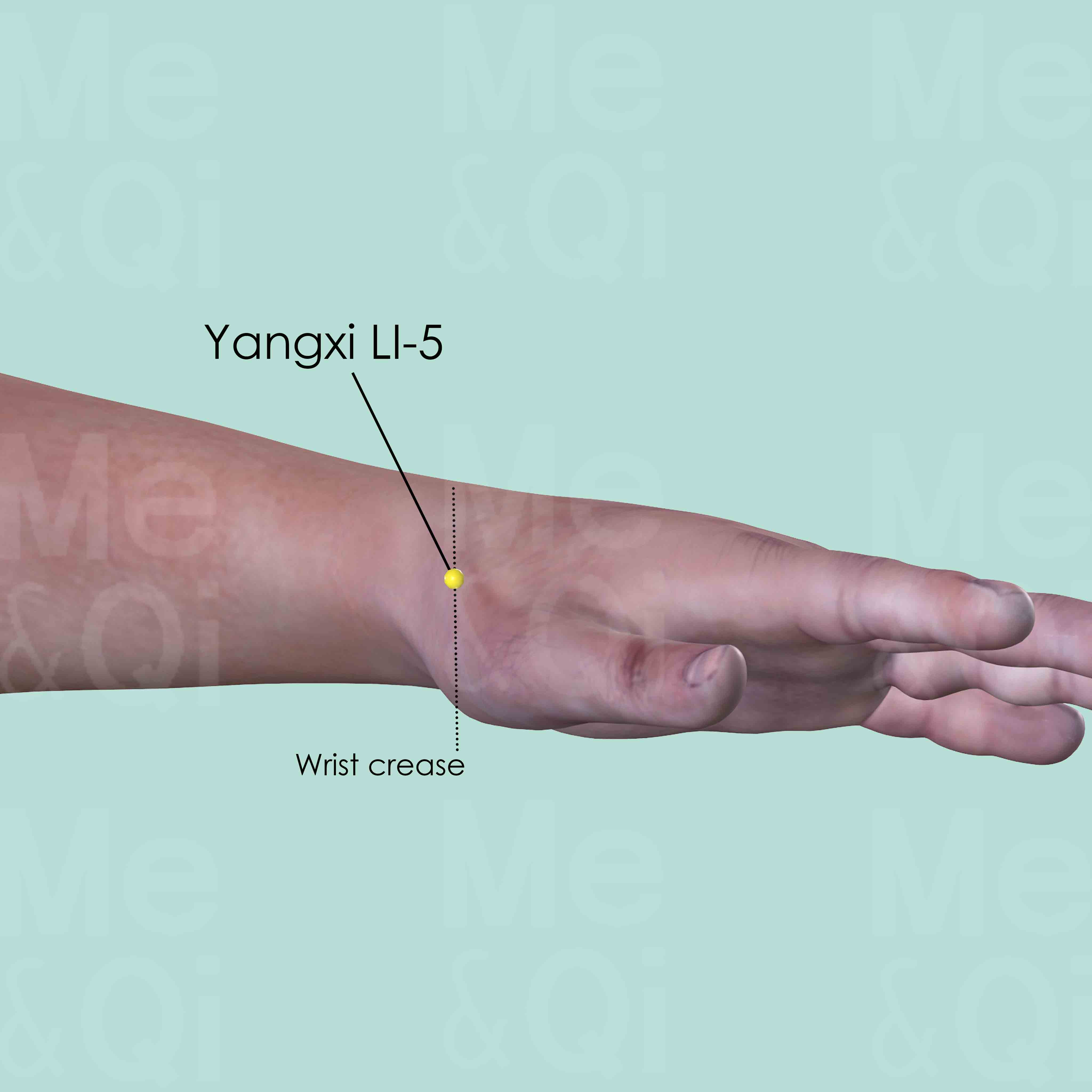
Yangxi LI-5
On the radial side of the wrist. When the thumb is tilted upward, it is in the depression on the wrist joint space (wrist crease) between the tendons of extensor pollicis longus and brevis muscles.
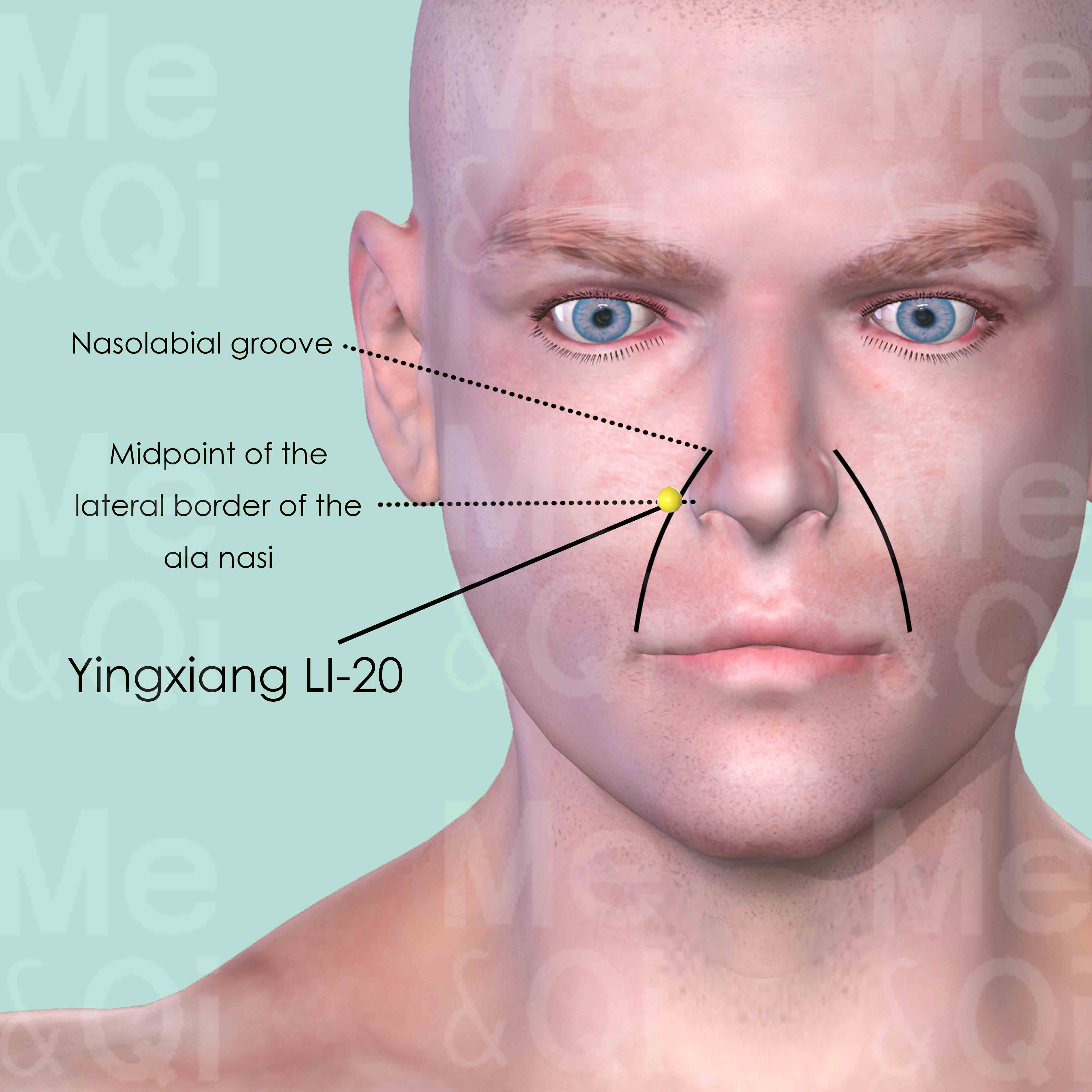
Yingxiang LI-20
In the nasolabrial groove, at the level of the midpoint of the lateral border of ala nasi.

Shaoze SI-1
On the ulnar side of the little finger, about 0.1 cun posterior to the corner of the nail.
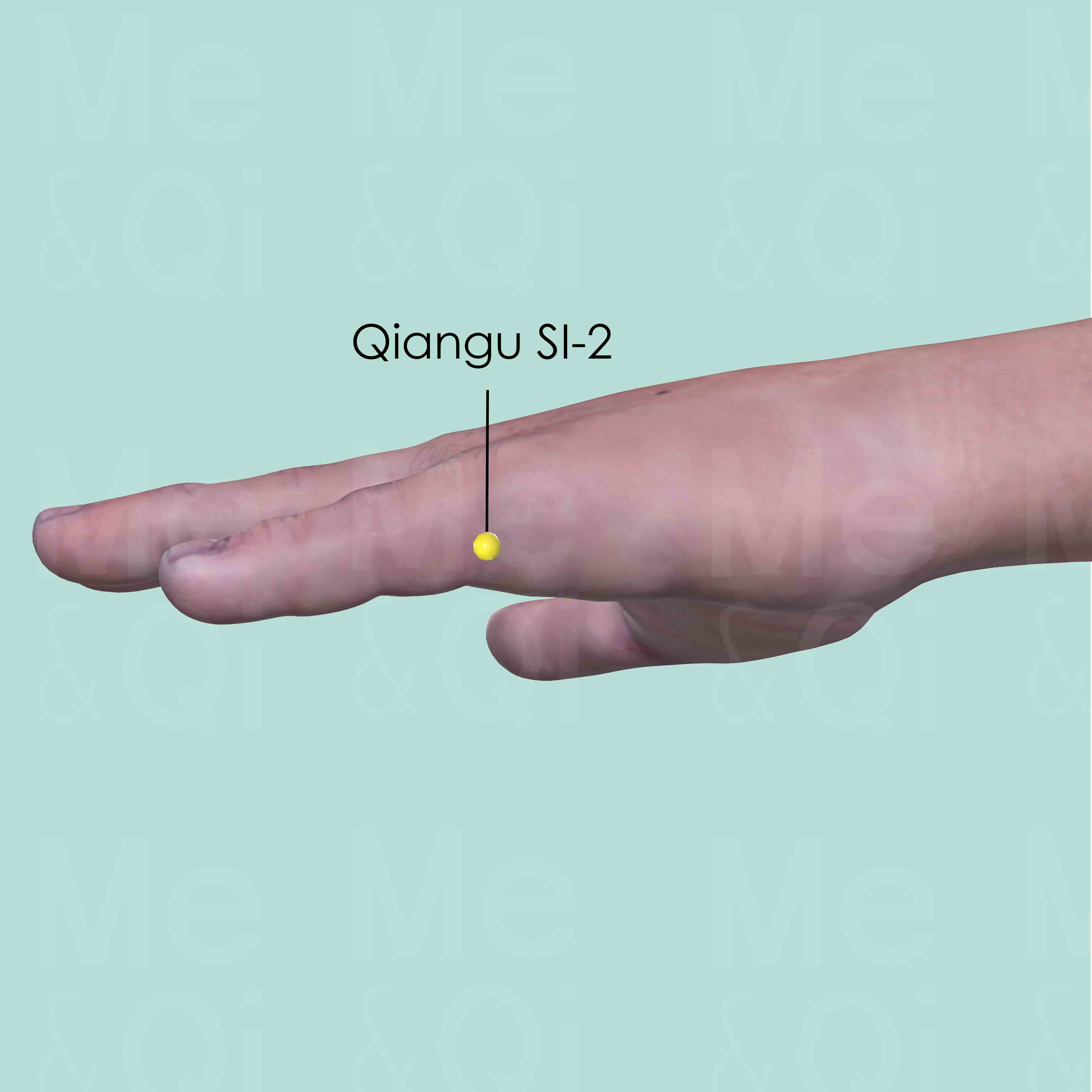
Qiangu SI-2
On the ulnar aspect of the little finger, distal to the metacarpophalangeal joint, at the junction of the shaft and the base of the proximal phalanx.
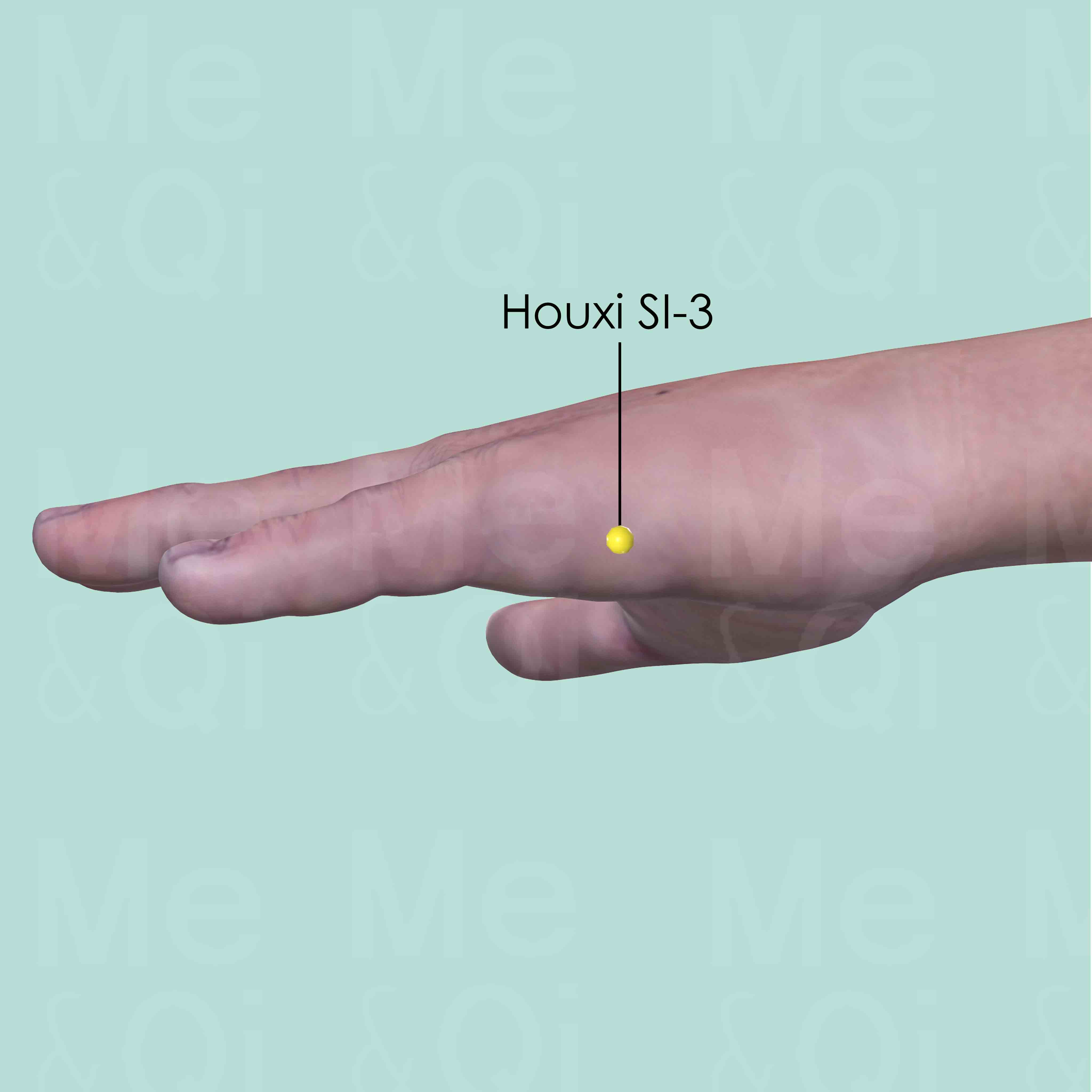
Houxi SI-3
Proximal to the head of the 5th metacarpal bone on the ulnar side, in the depression at the junction of the red and white skin.
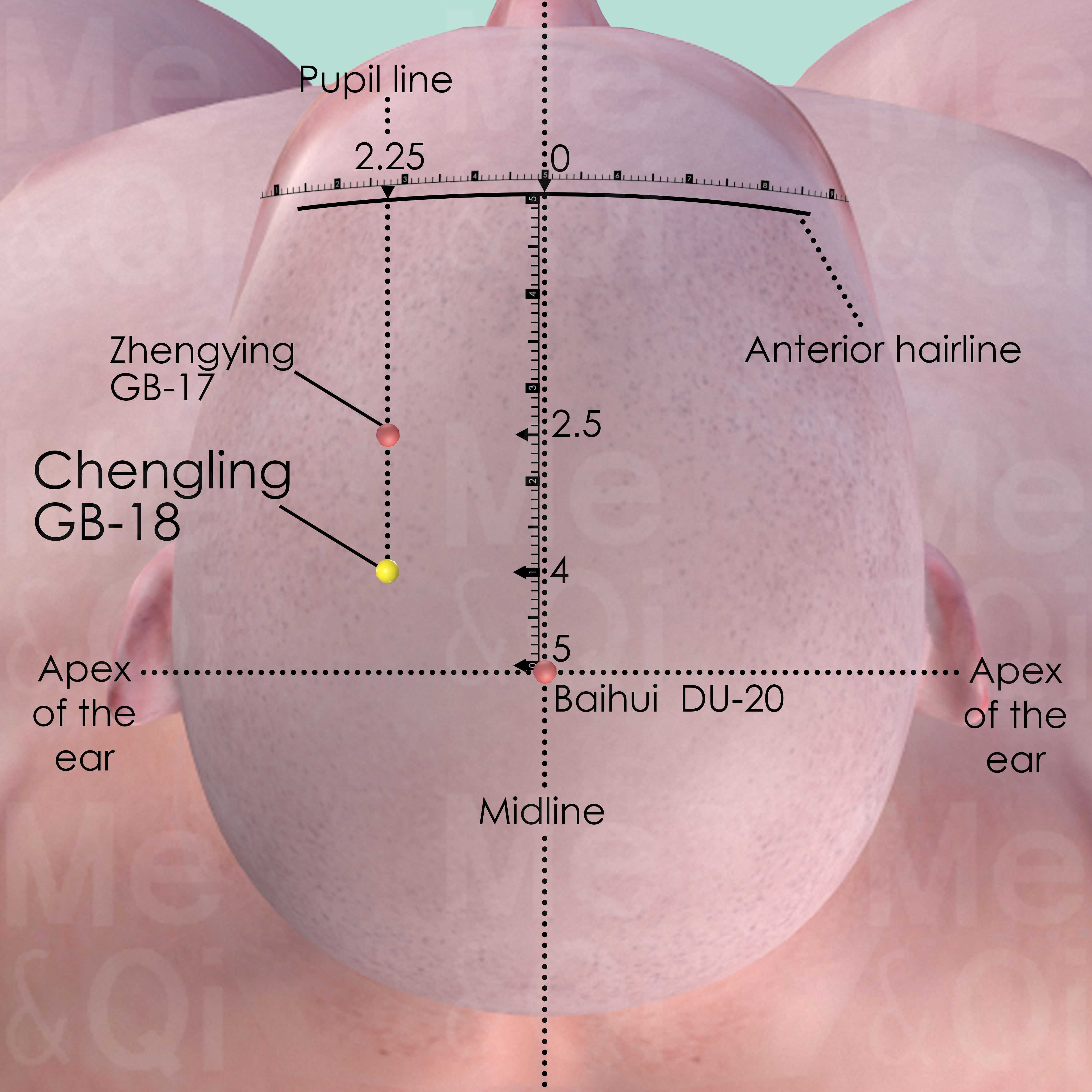
Chengling GB-18
1.5 cun posterior to Zhengying GB-17 or 4 cun posterior to the anterior hairline. Or 1 cun anterior and 2.25 cun lateral to Baihui DU-20, which is at the vertex of the head.
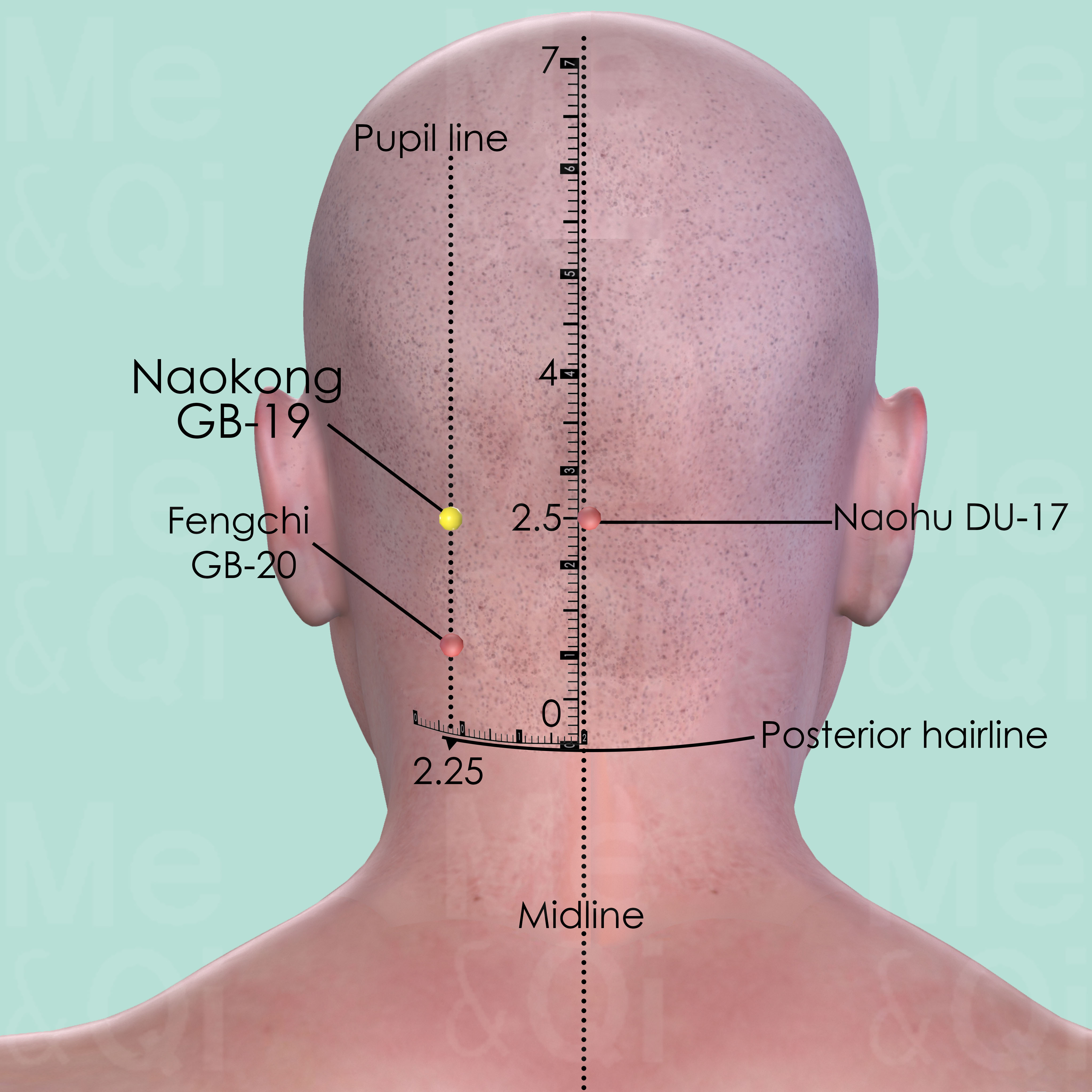
Naokong GB-19
Directly above Fengchi GB-20, level with Naohu DU-17, on the lateral side of the external occipital protuberance.
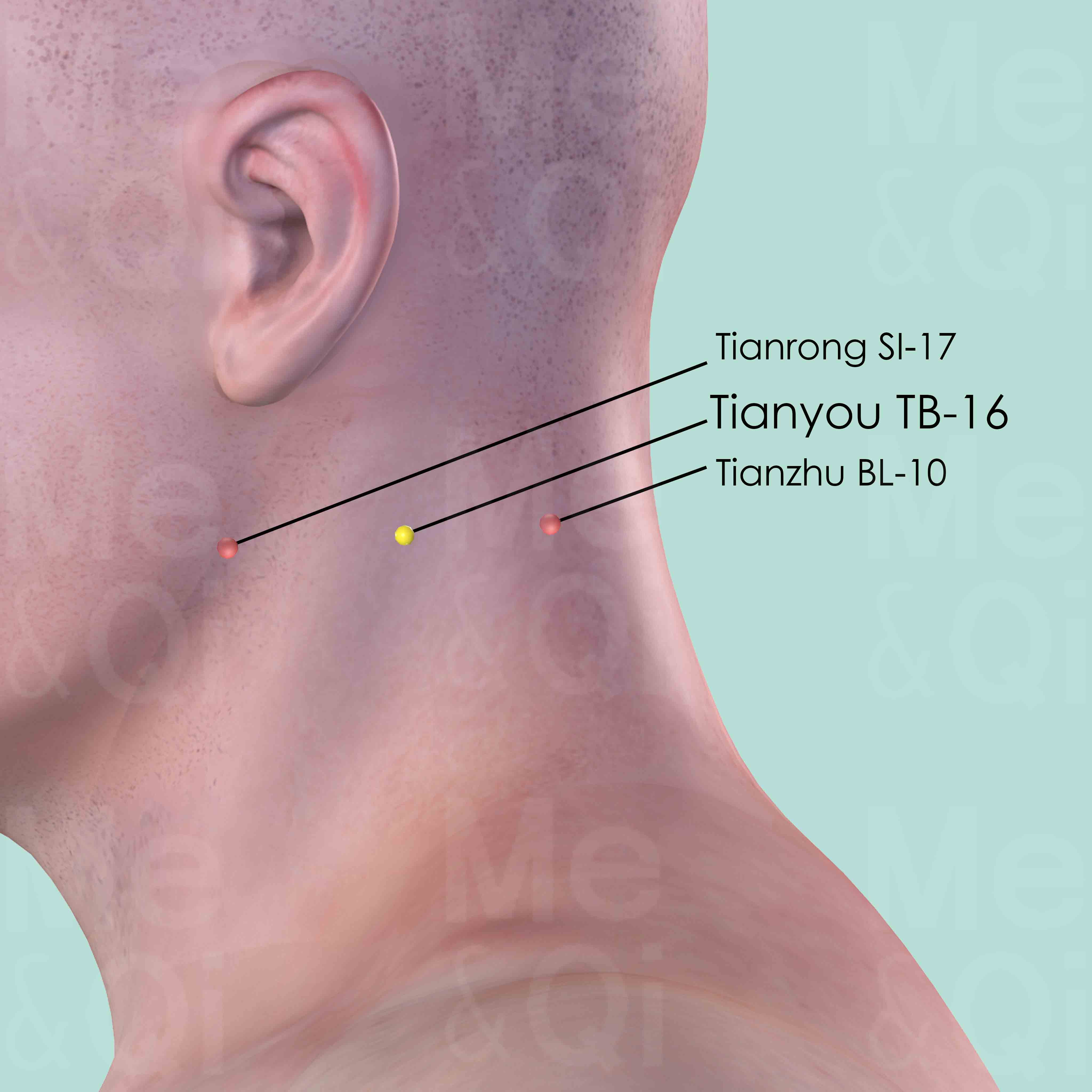
Tianyou TB-16
Posterior and inferior to the mastoid process, on the posterior border of sternocleidomastoid muscle, level with Tianrong SI-17 and Tianzhu BL-10.
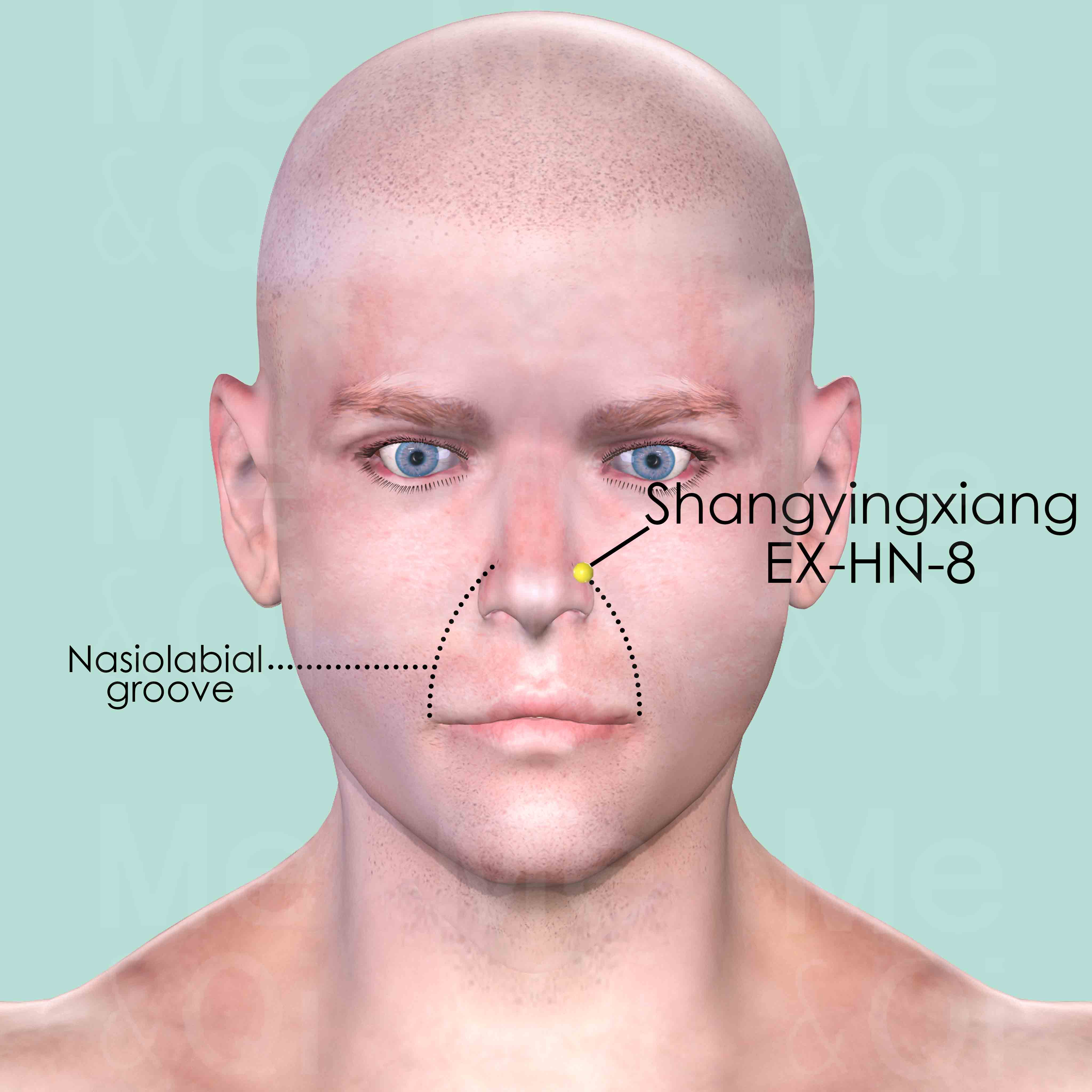
Shangyingxiang EX-HN-8
At the upper end of the nasiolabial groove, at the junction of the maxilla and the nasal cavity.
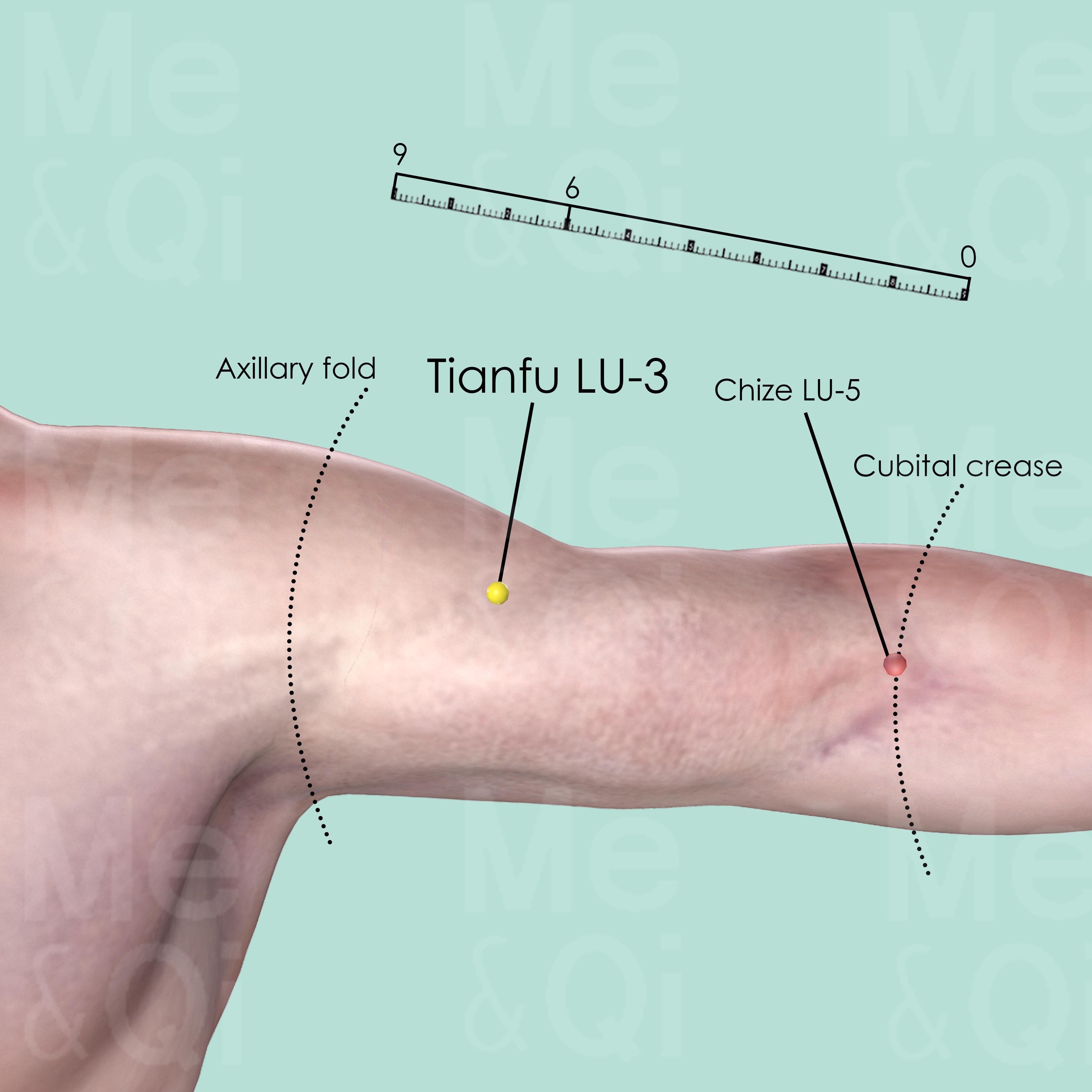
Tianfu LU-3
On the medial aspect of the upper arm, 3 cun below the end of the axillary fold and 6 cun above Chize LU-5, in the depression on the lateral border of biceps muscle.
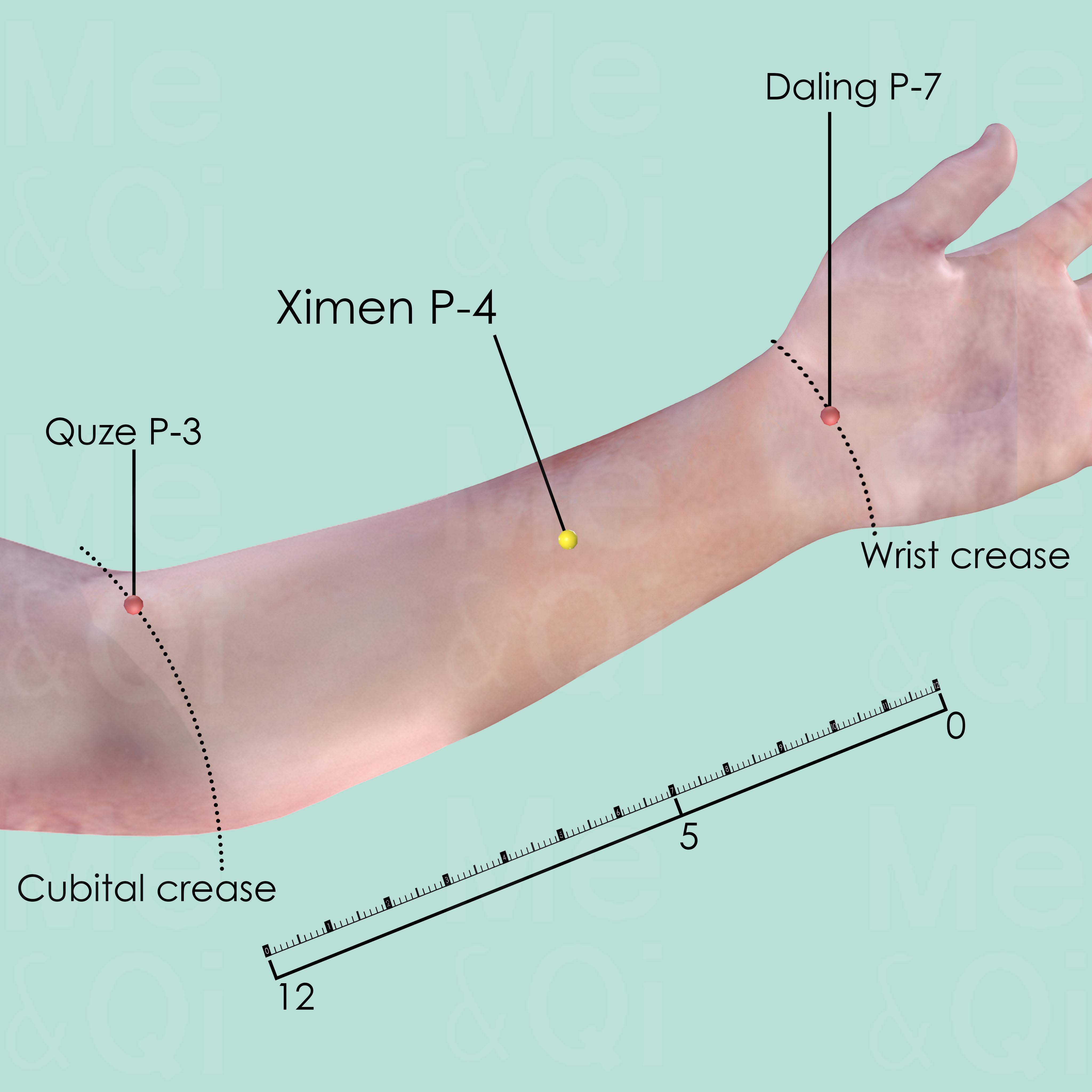
Ximen P-4
5 cun above the transverse crease of the wrist, on the line connecting Quze P-3 and Daling P-7, between the tendons of palmaris longus and flexor carpi radialis muscles.
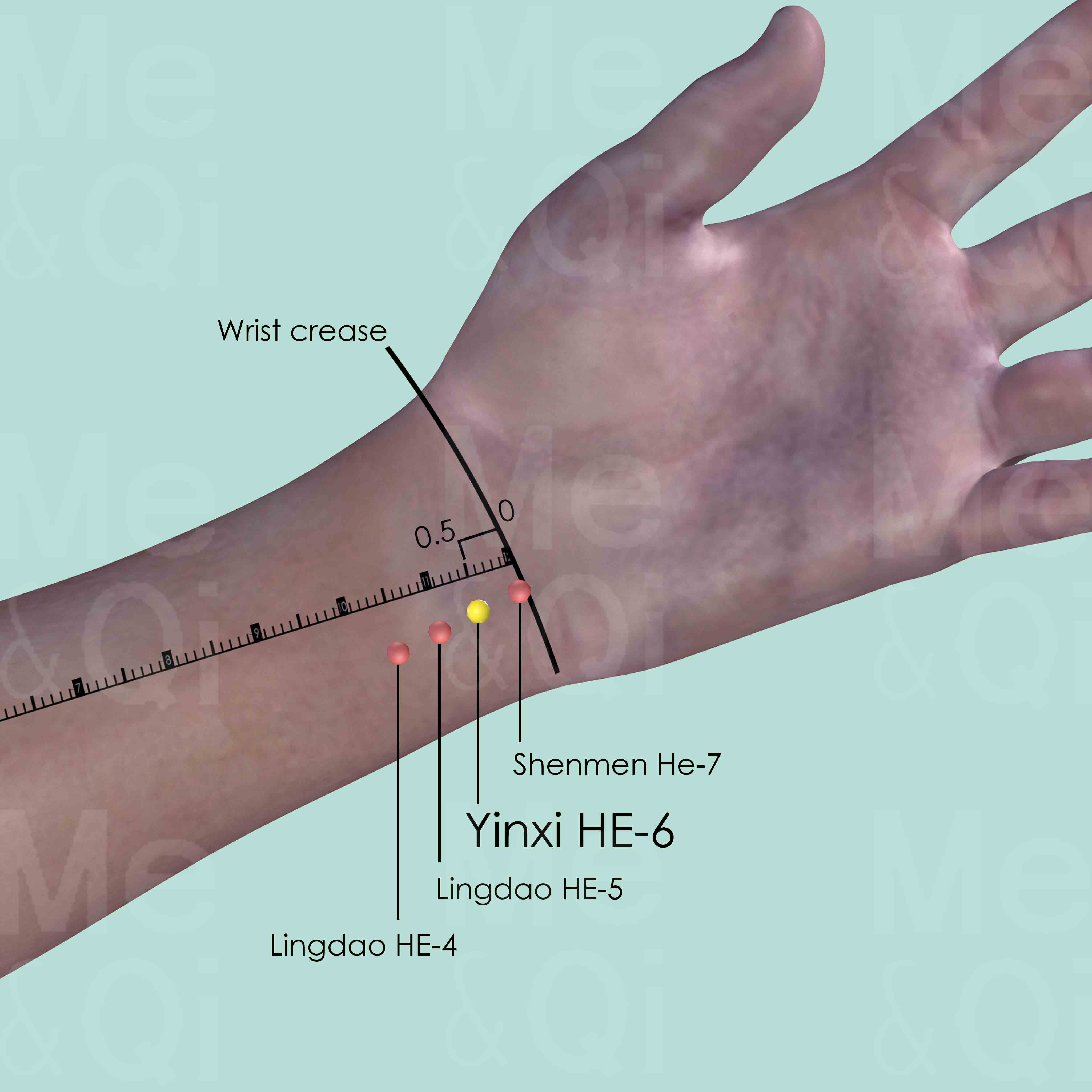
Yinxi HE-6
On the radial side of the tendon of flexor carpi ulnaris muscle, 0.5 cun above the transverse crease of the wrist when the palm faces upward.

